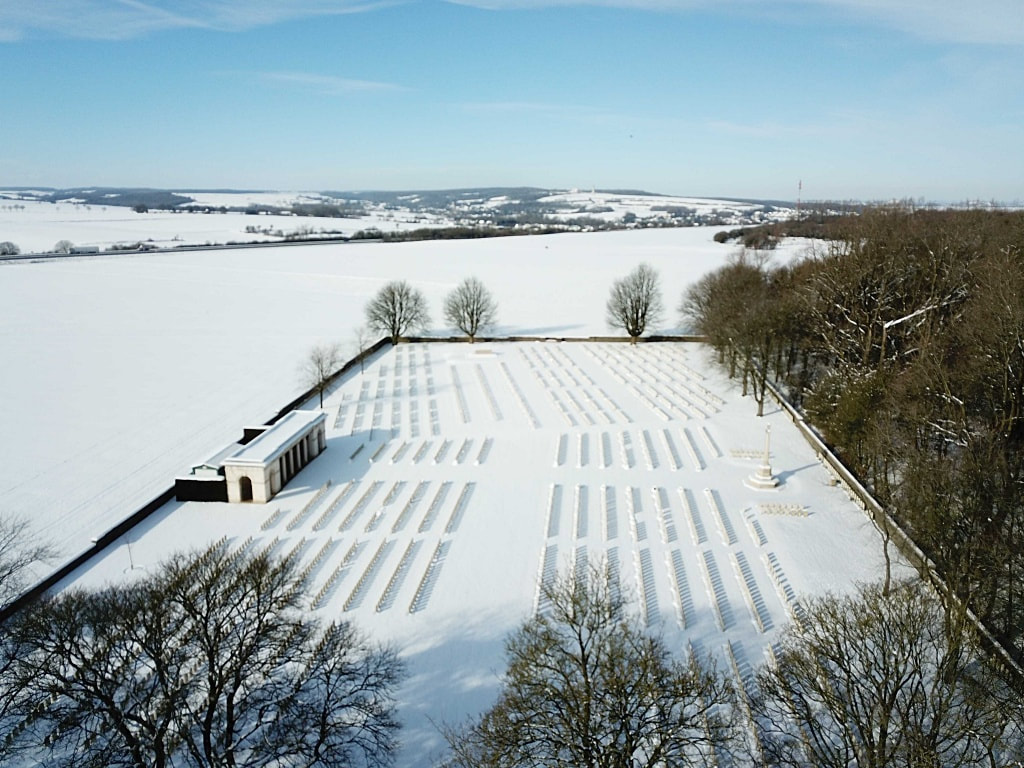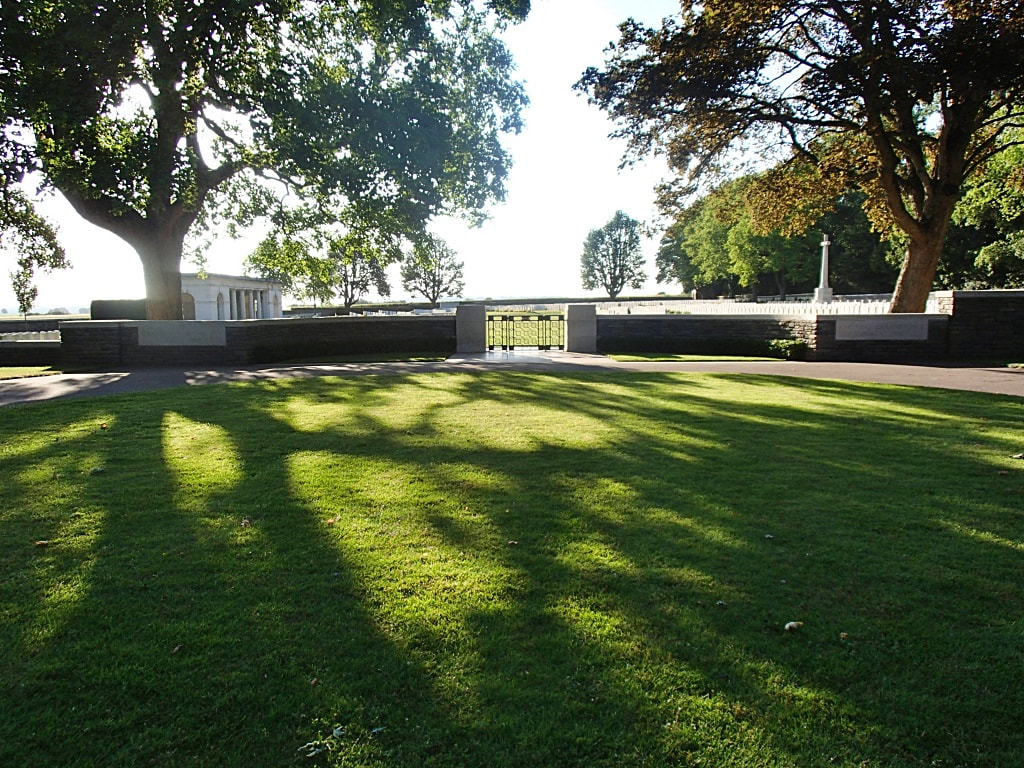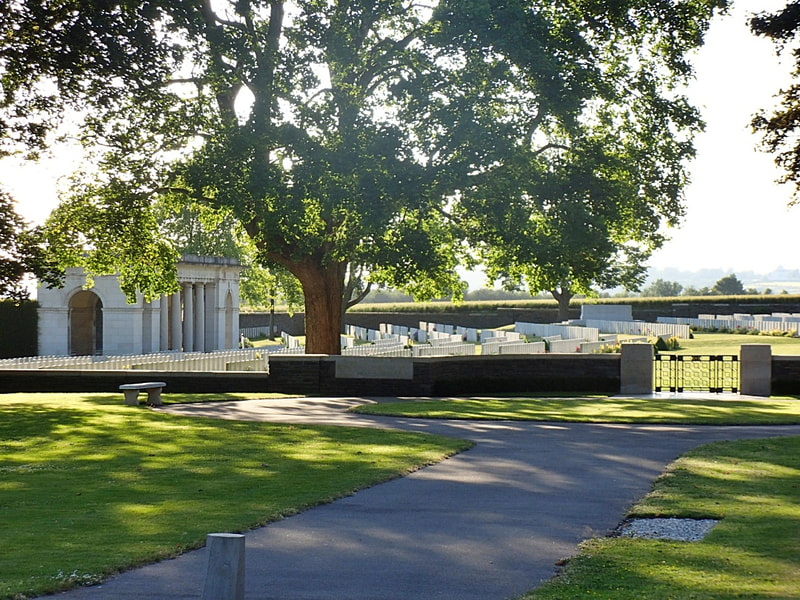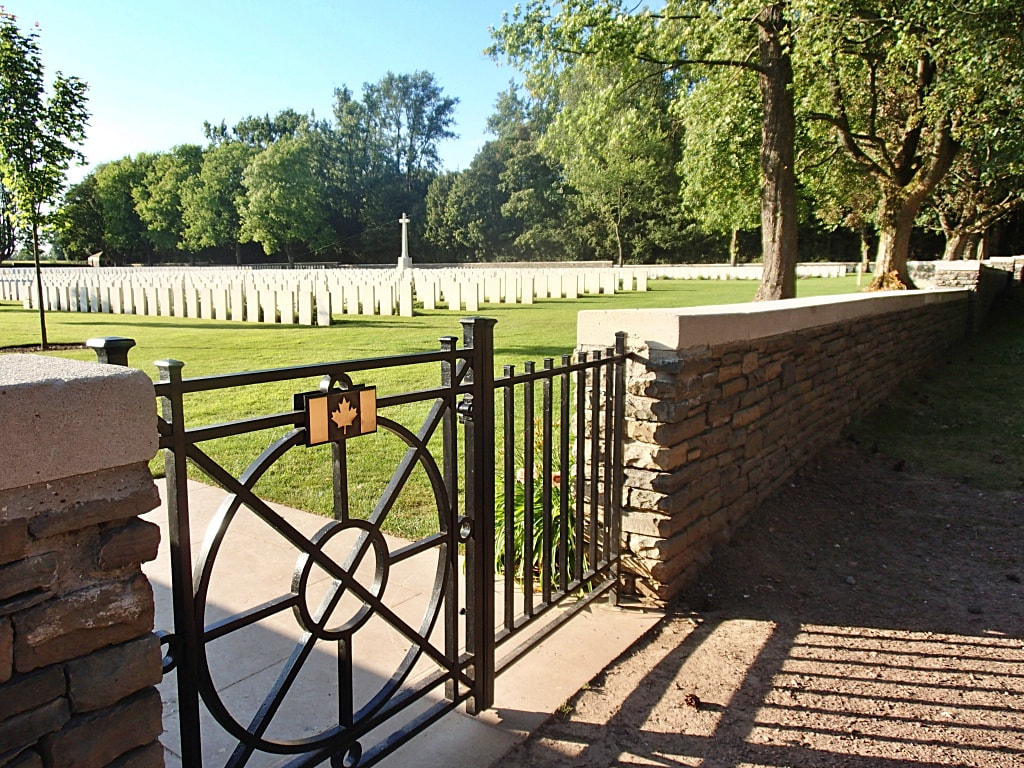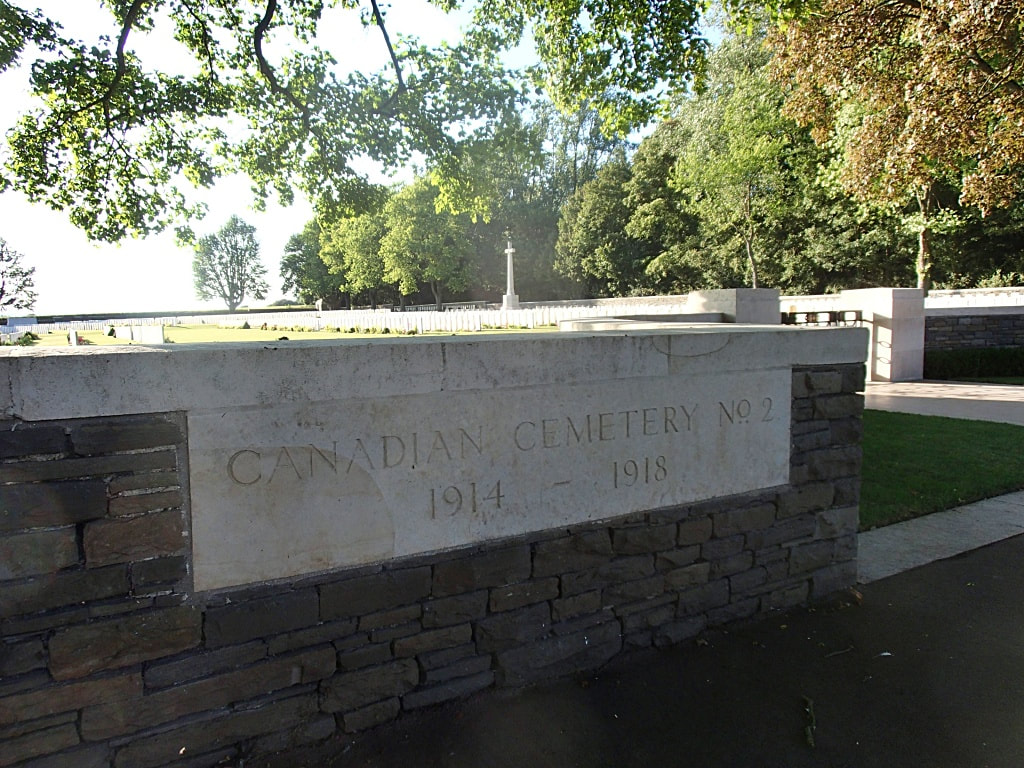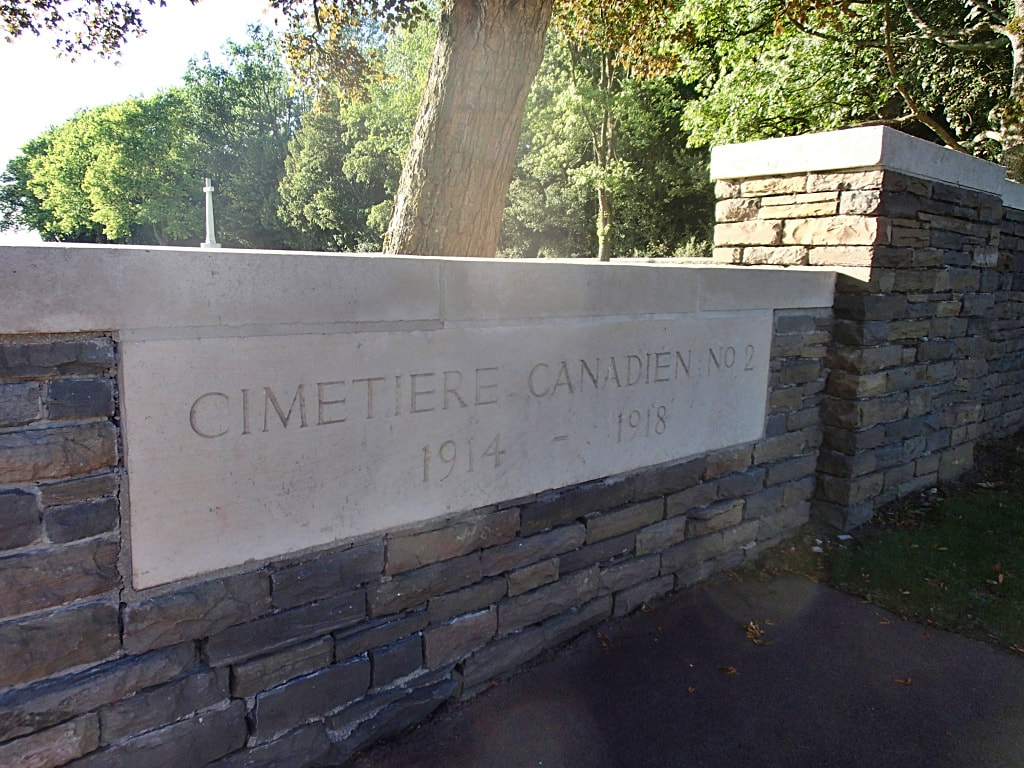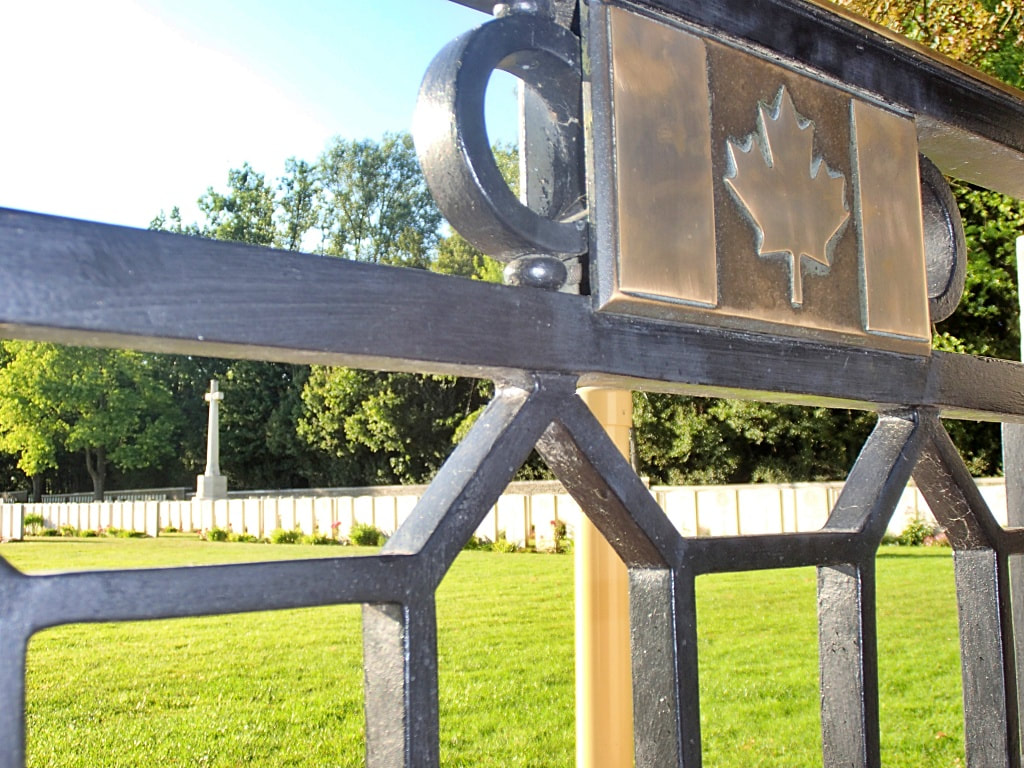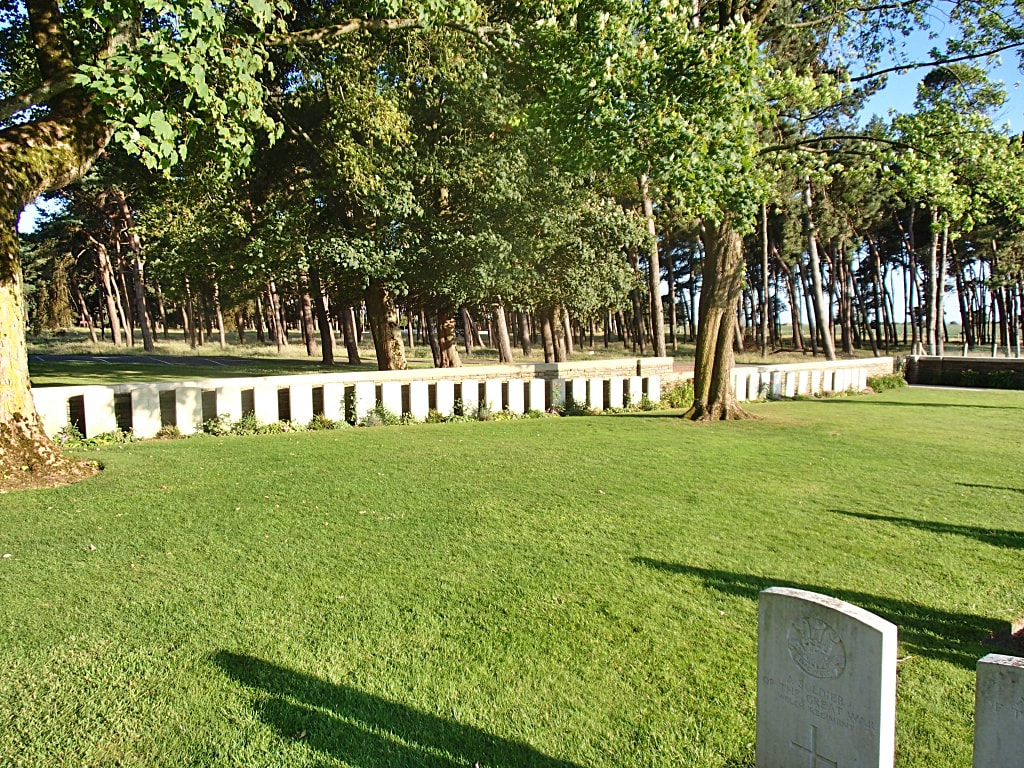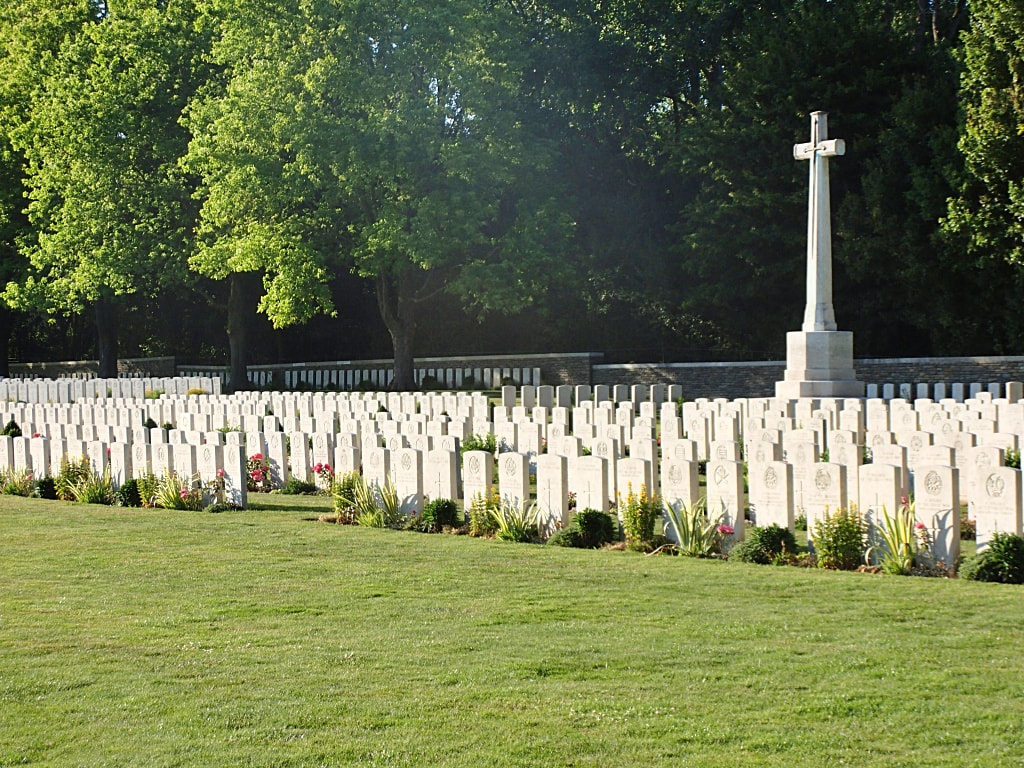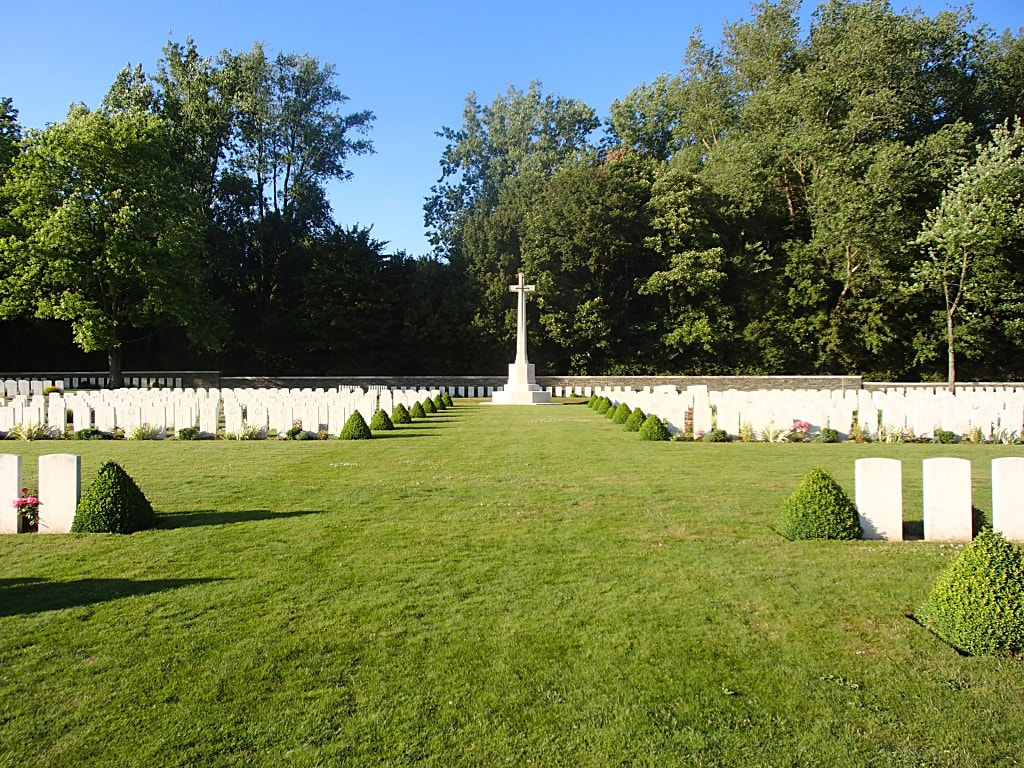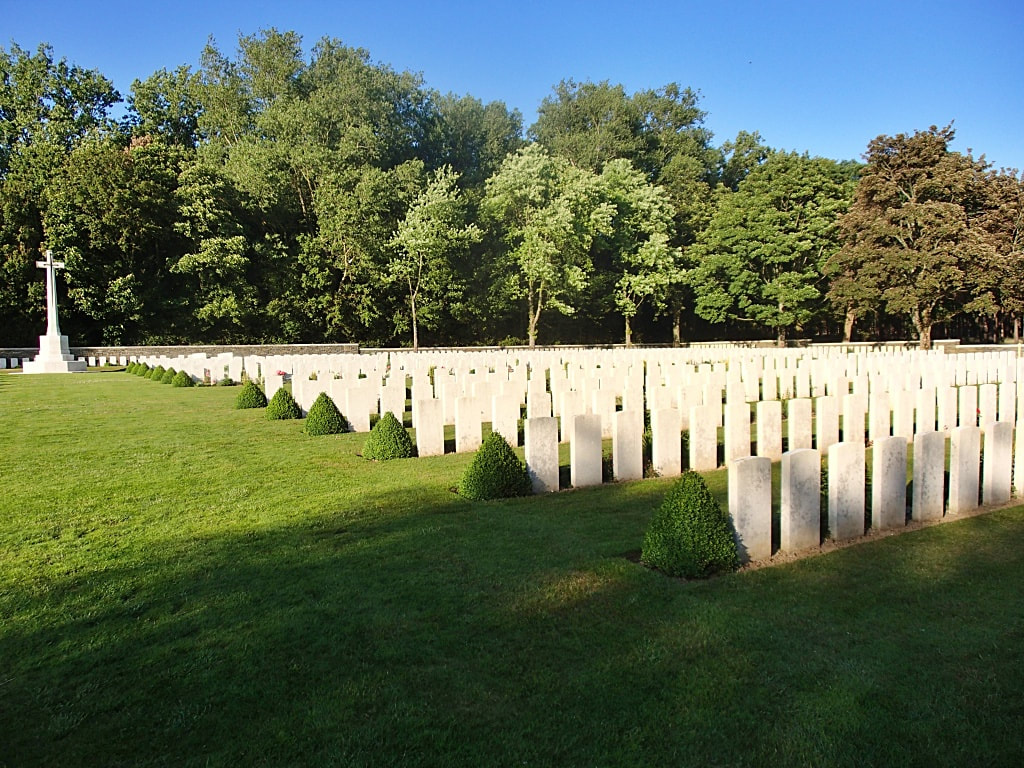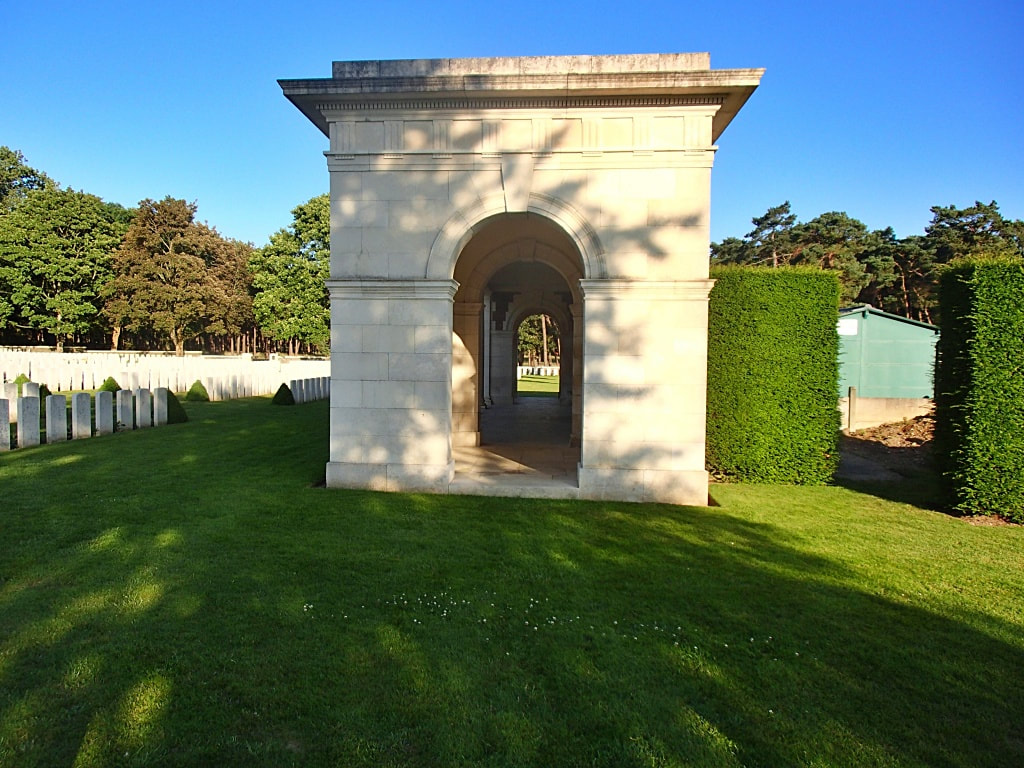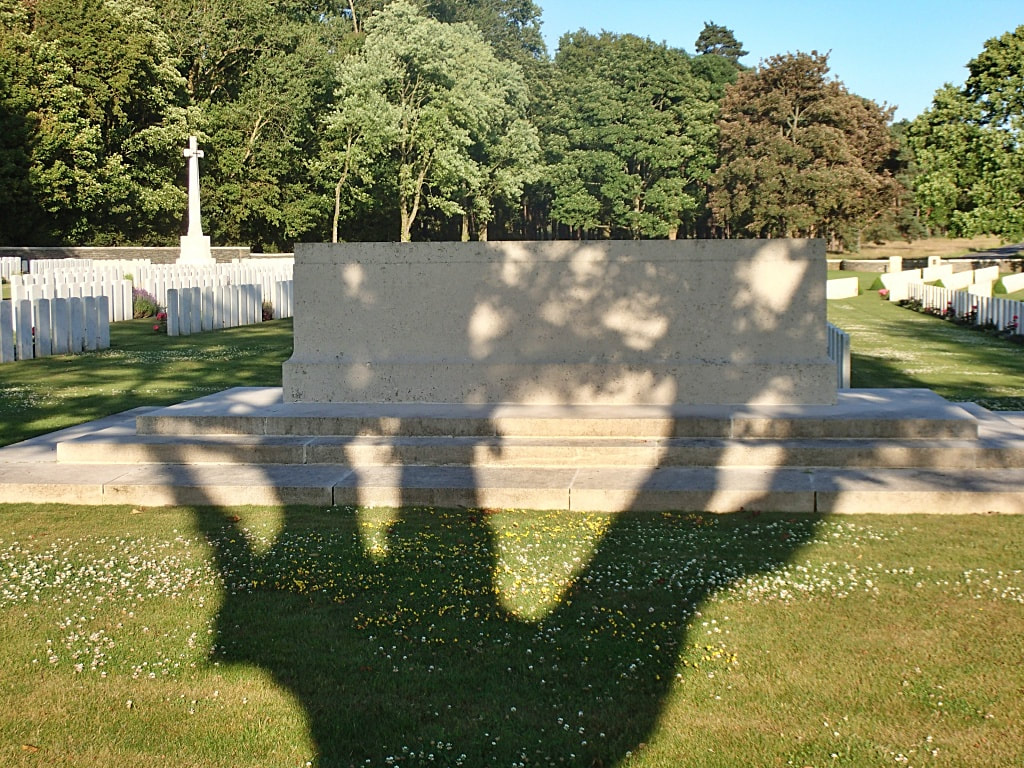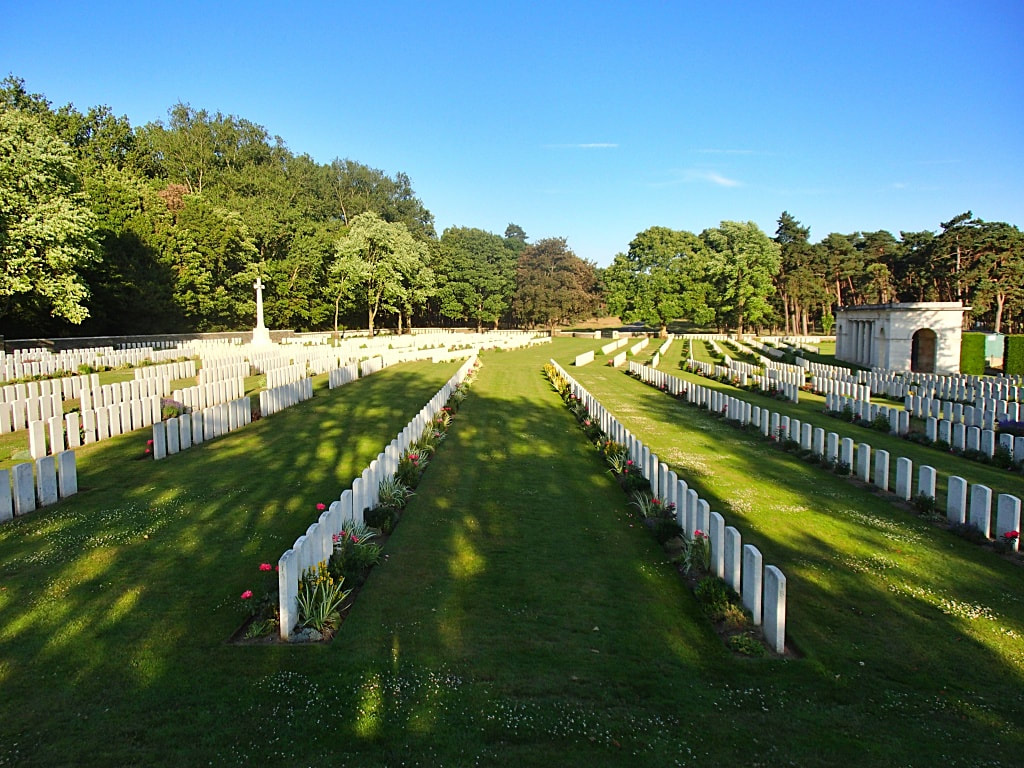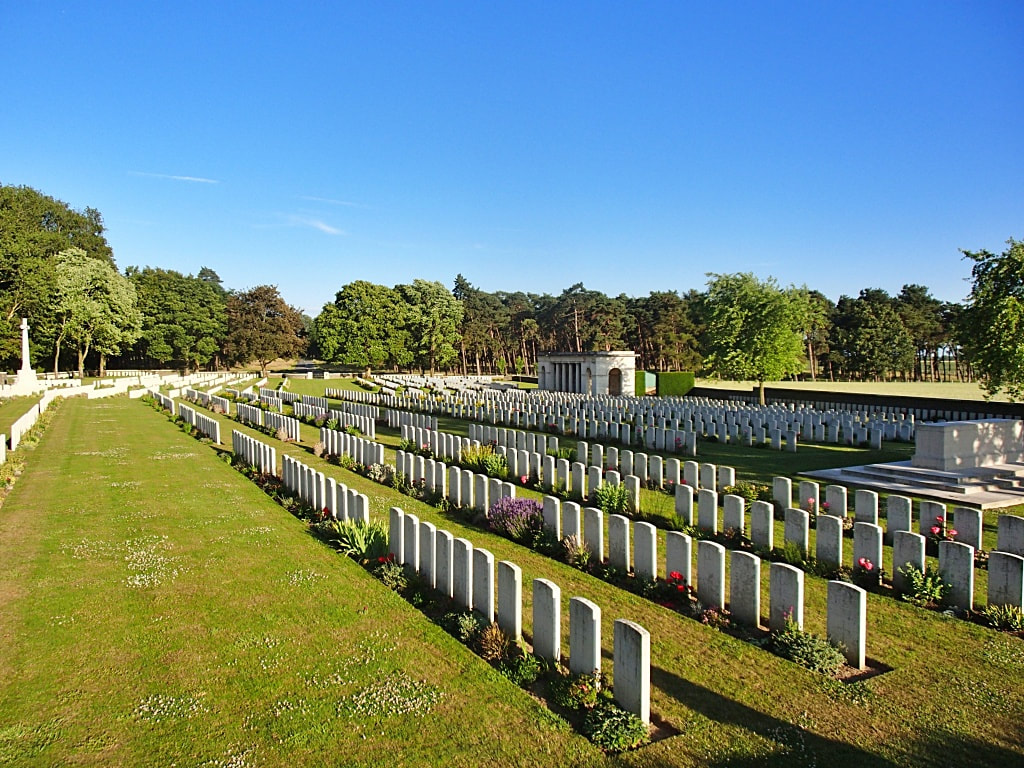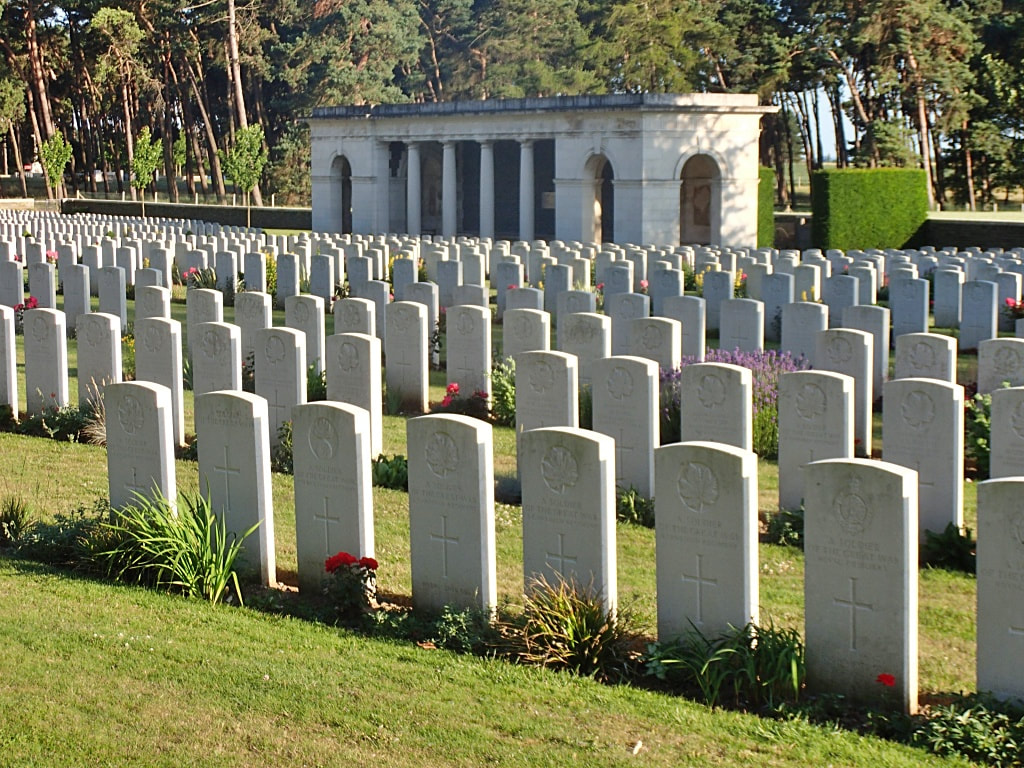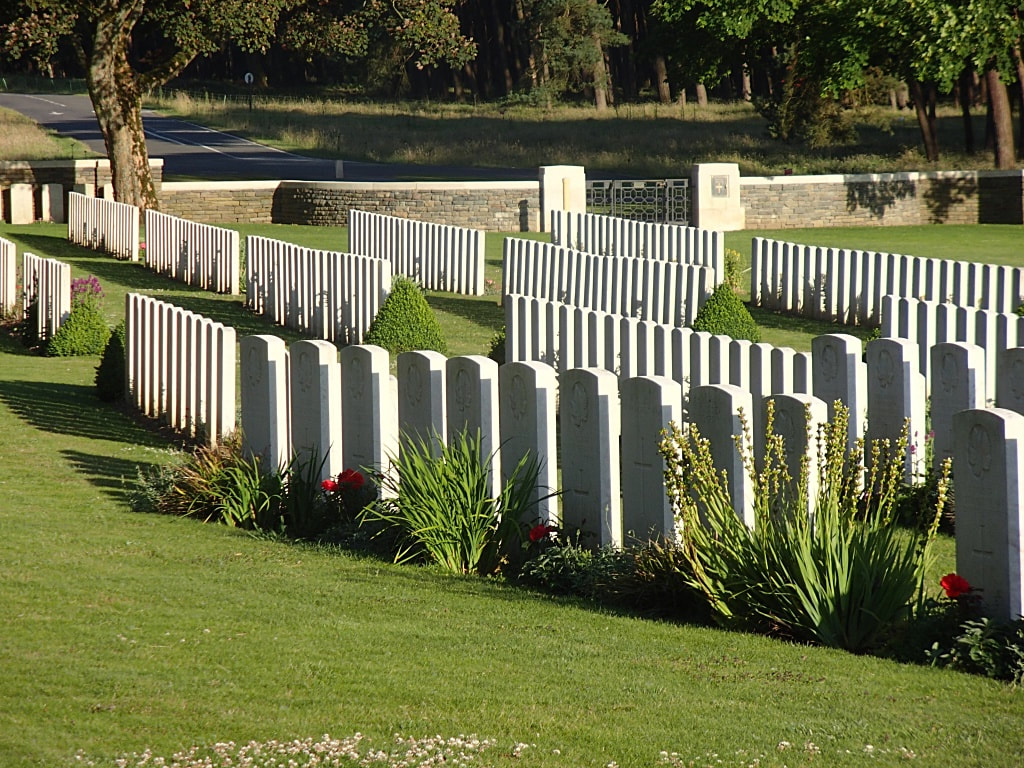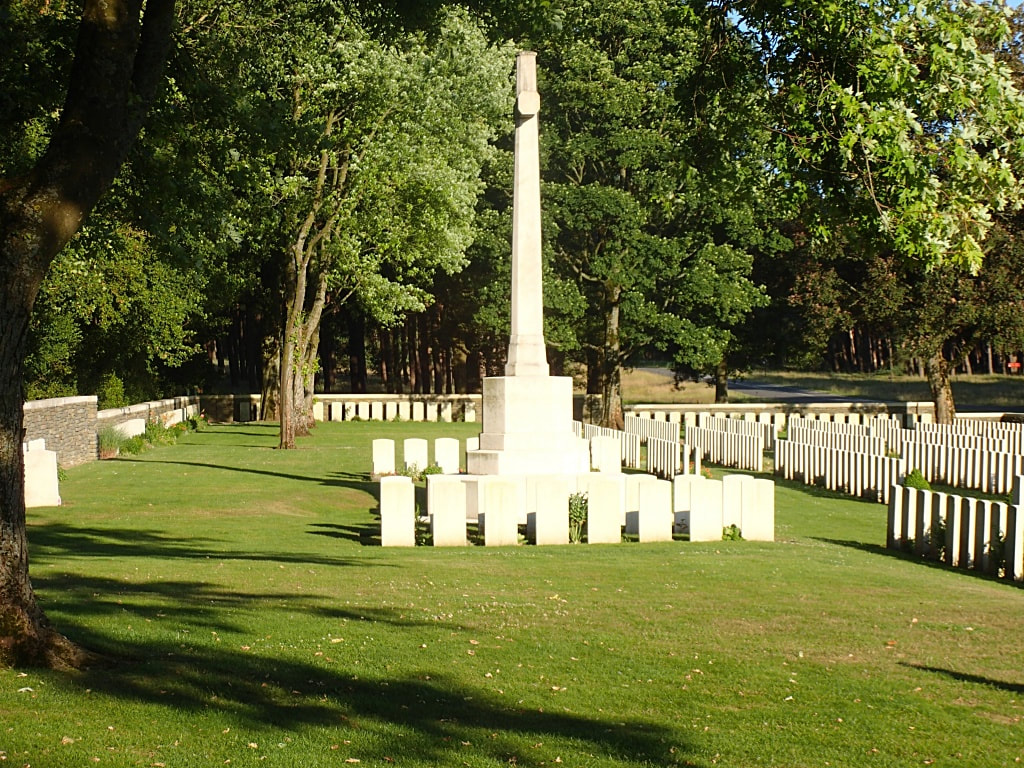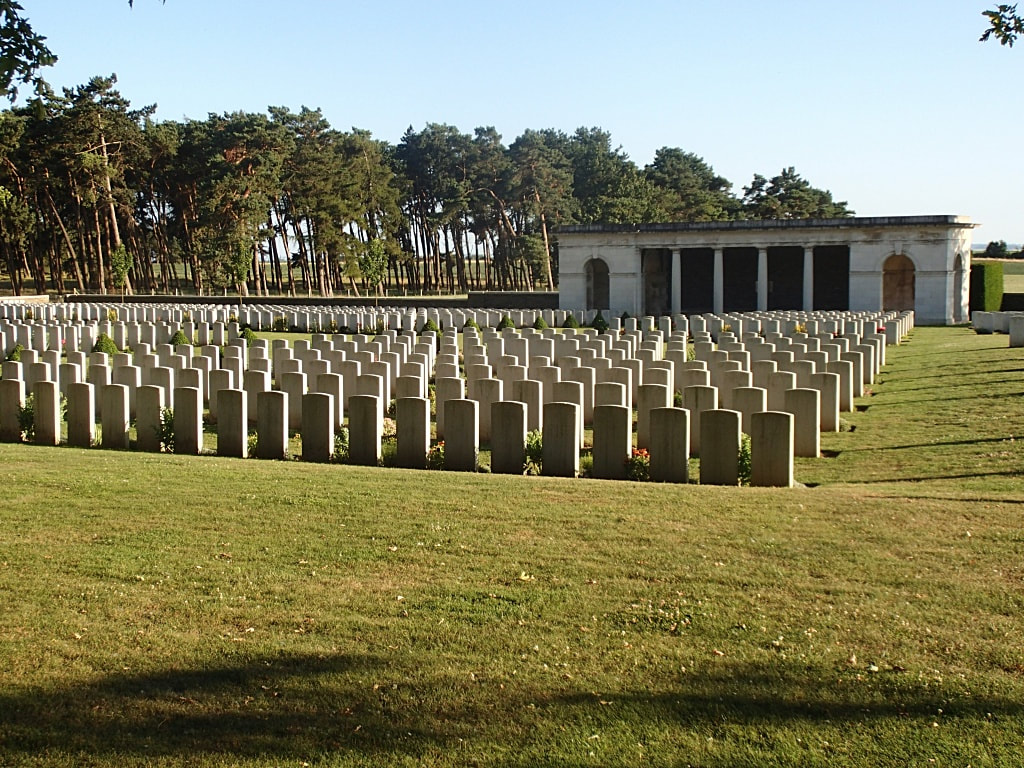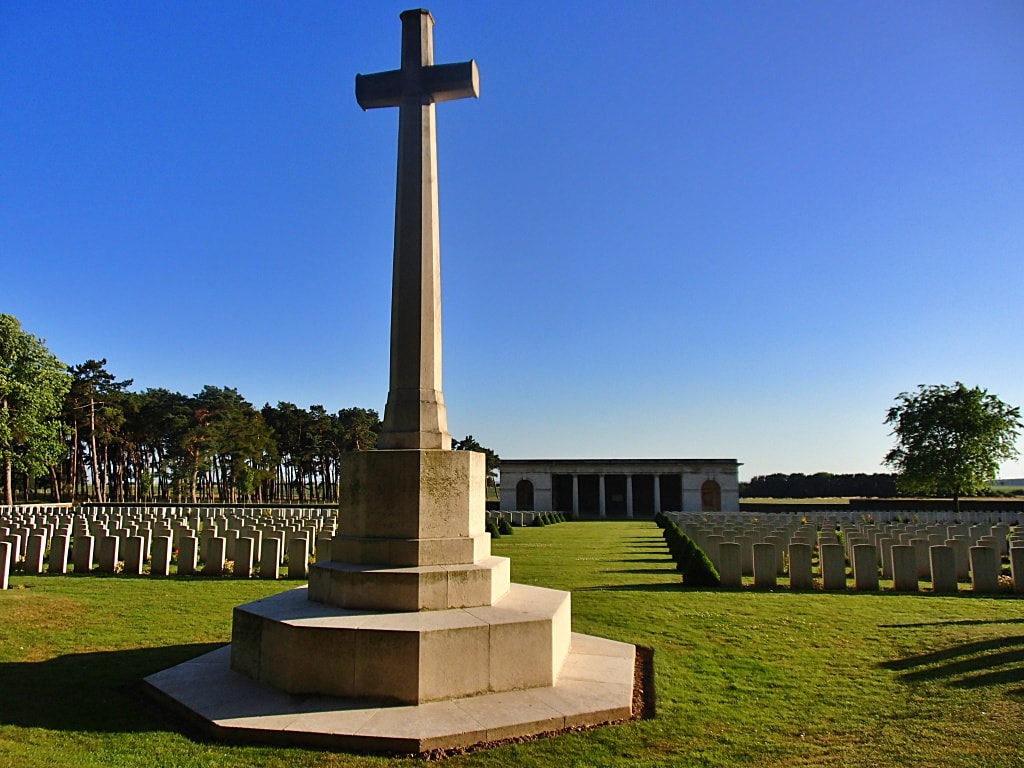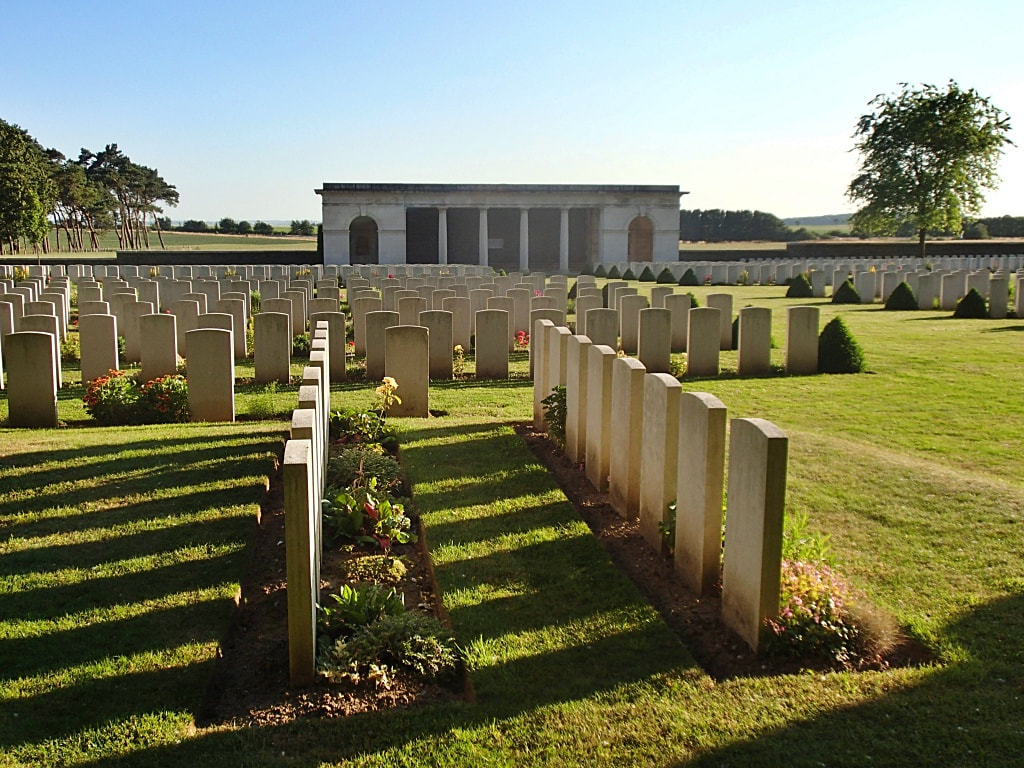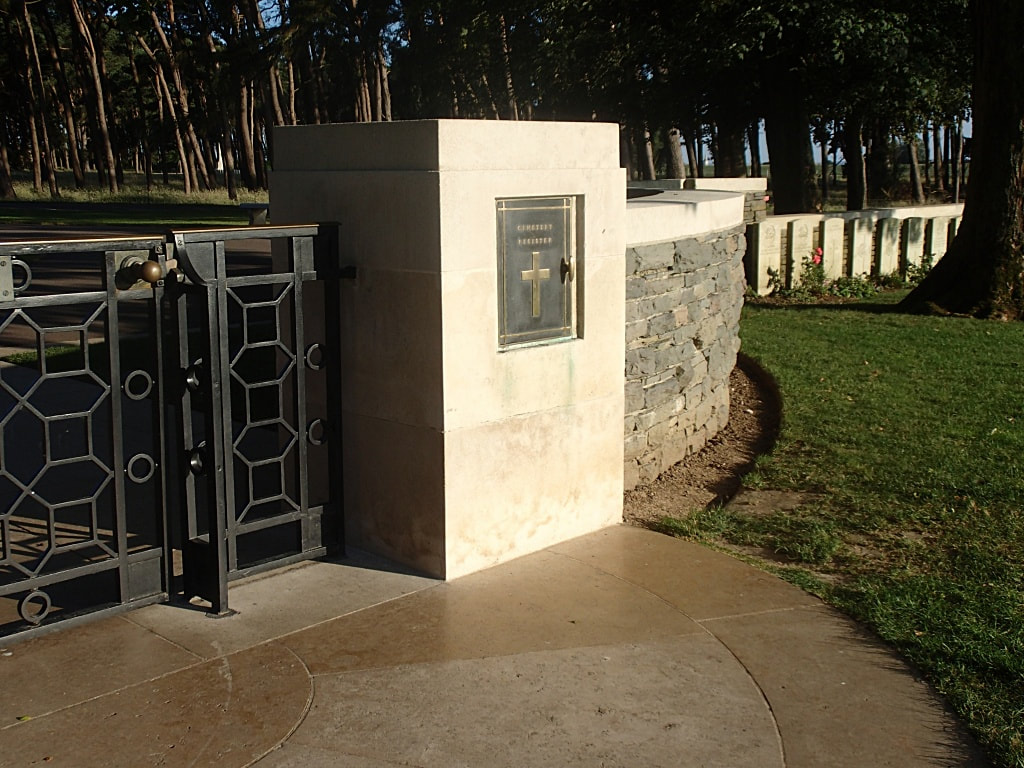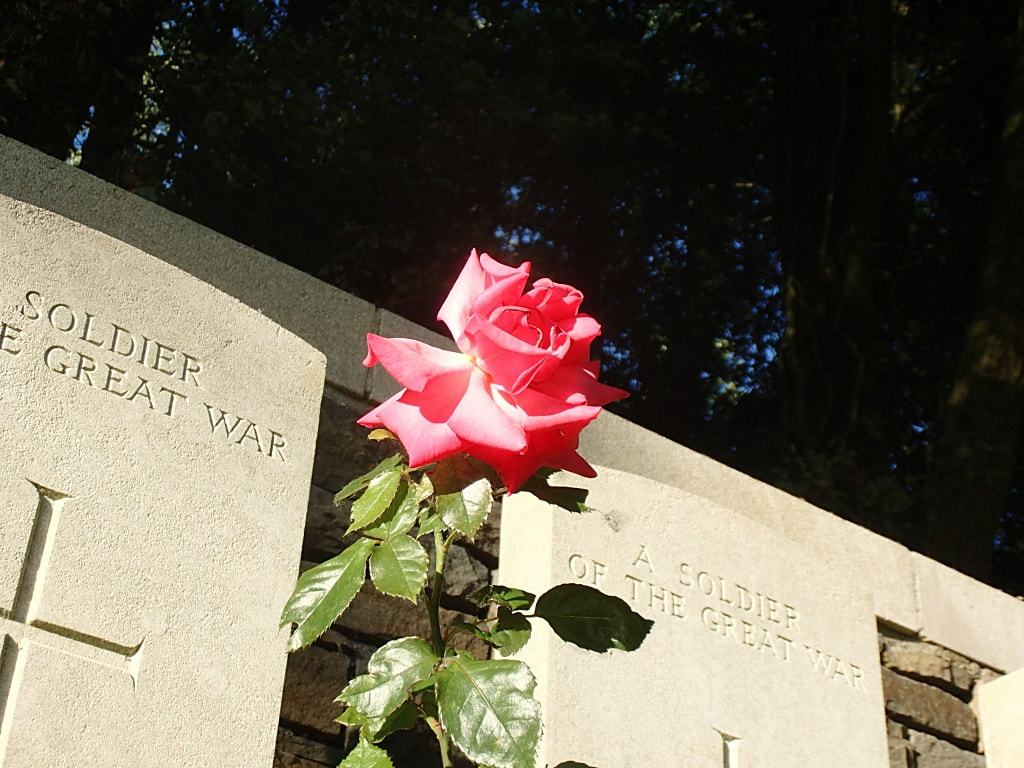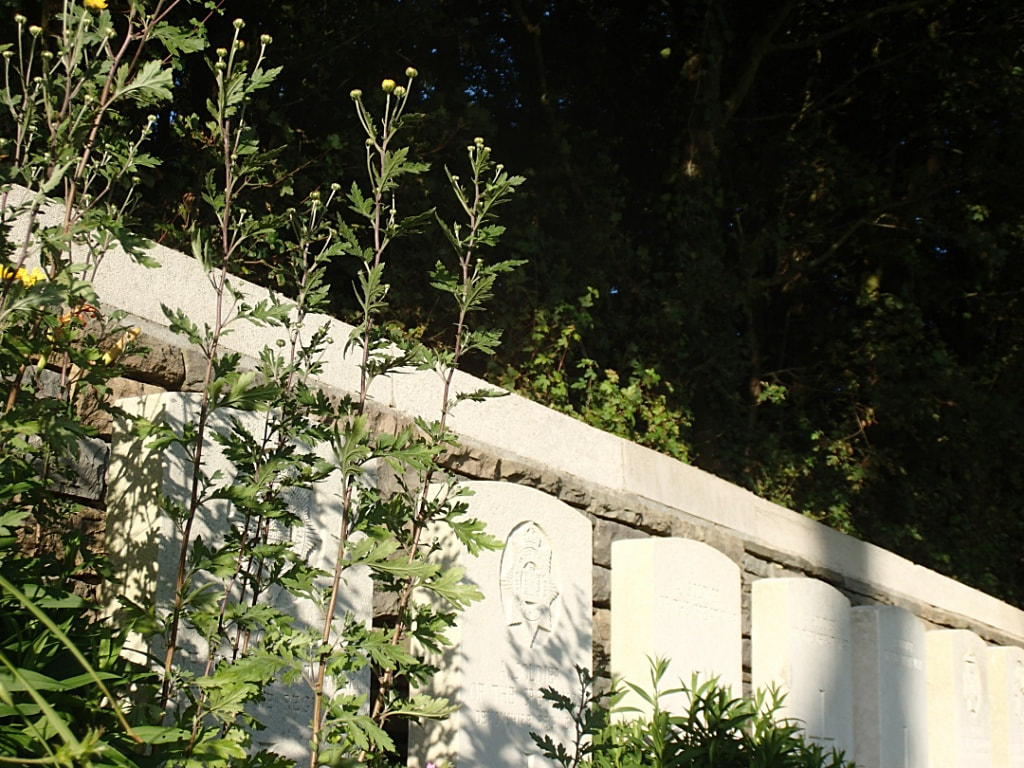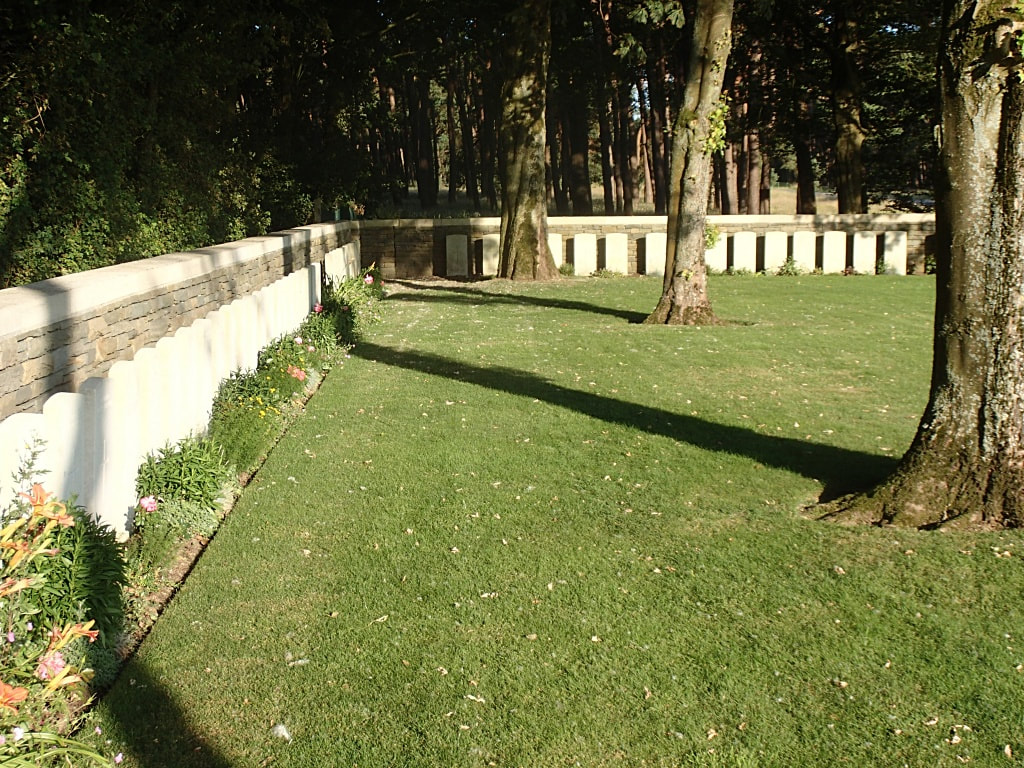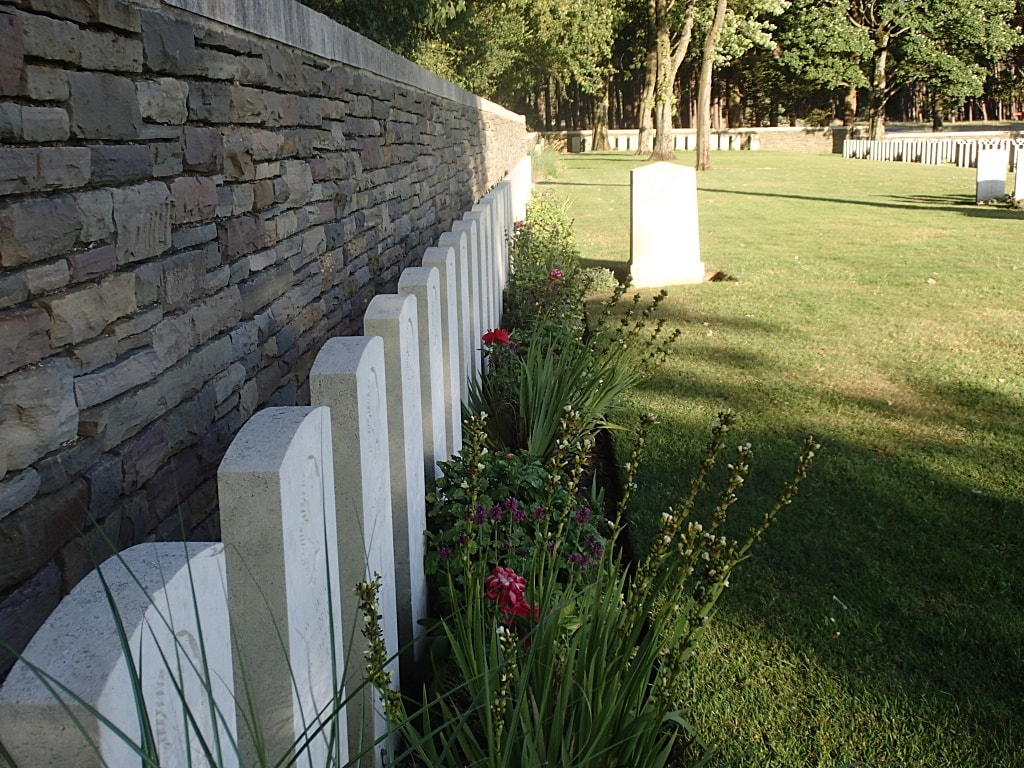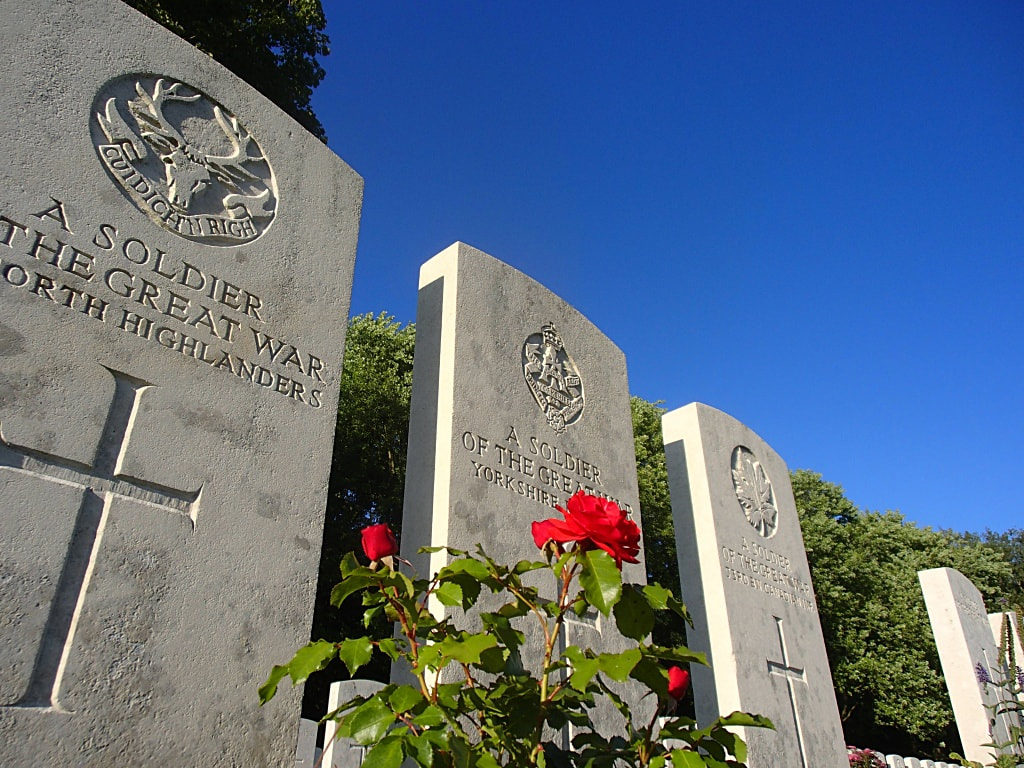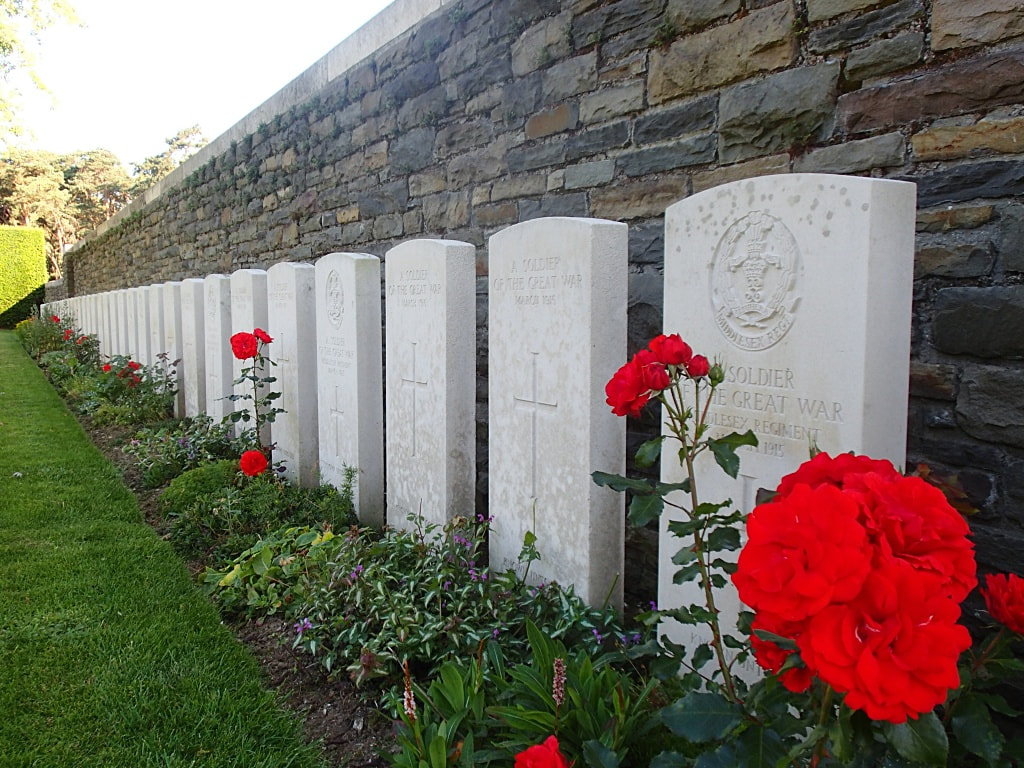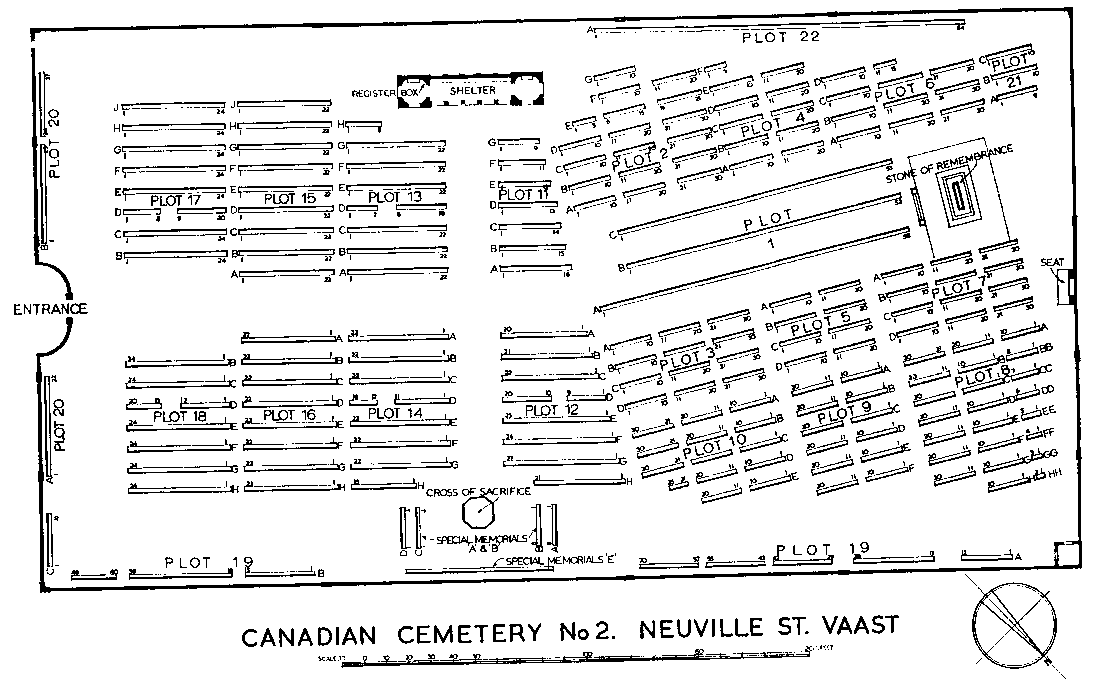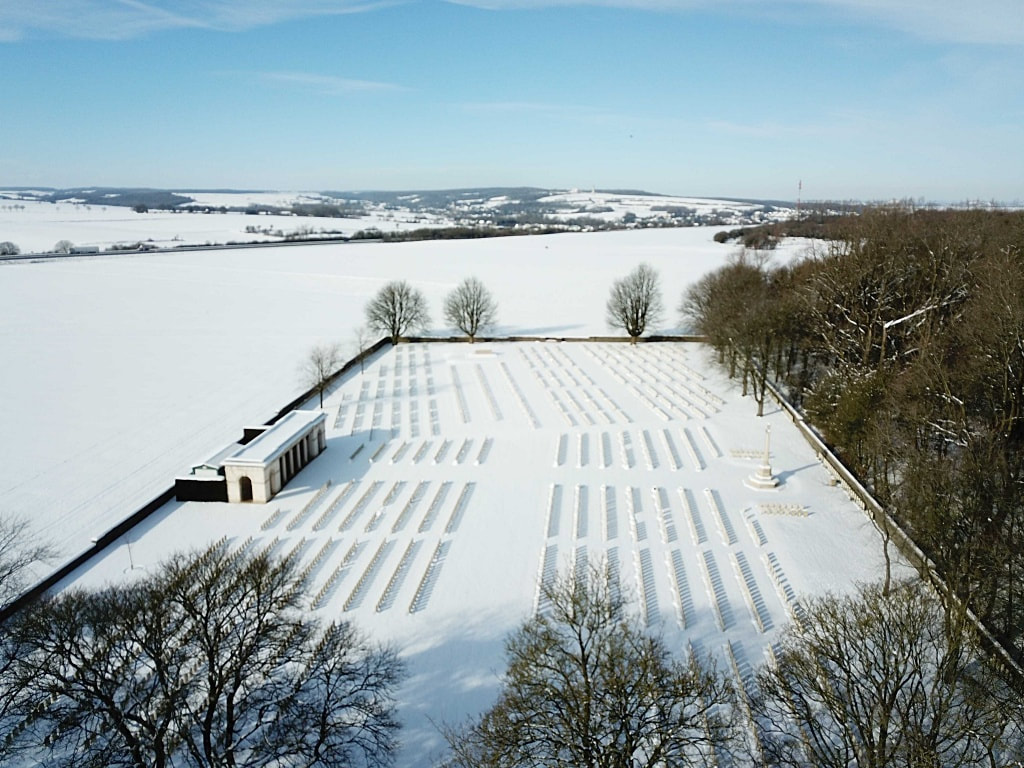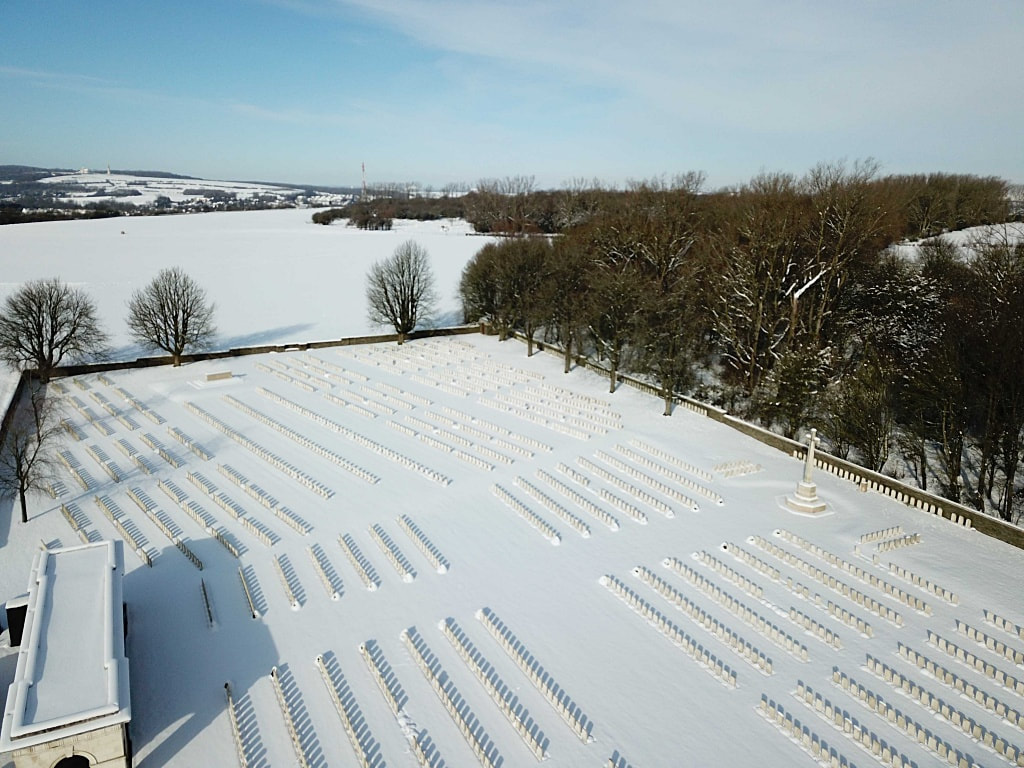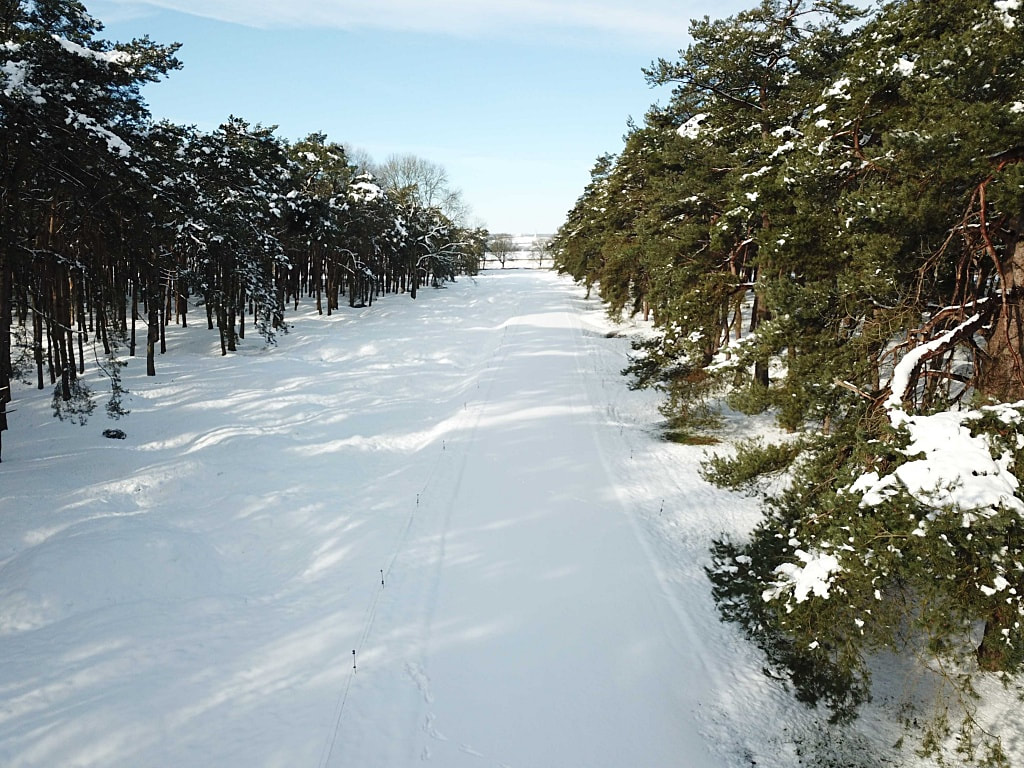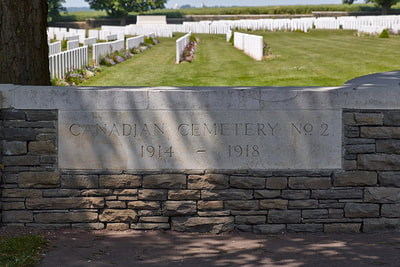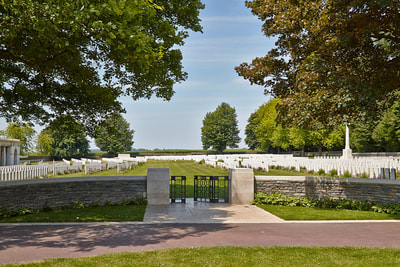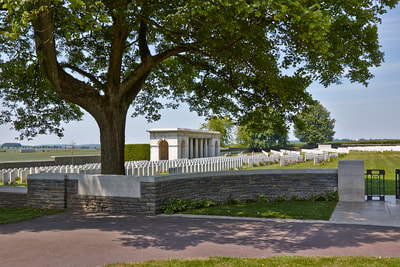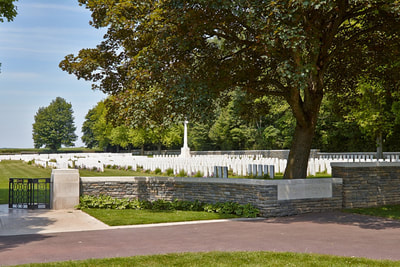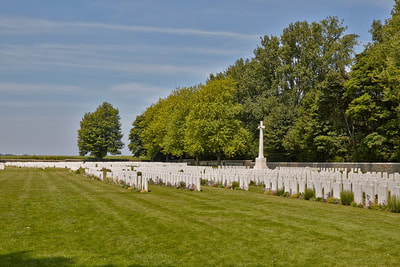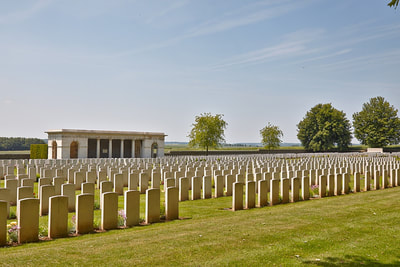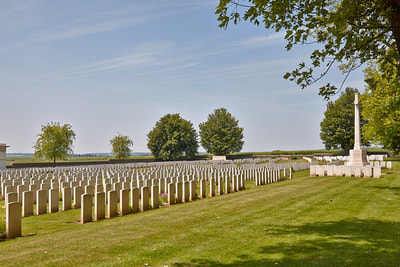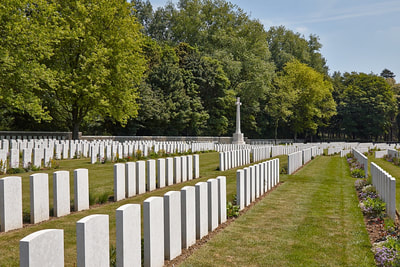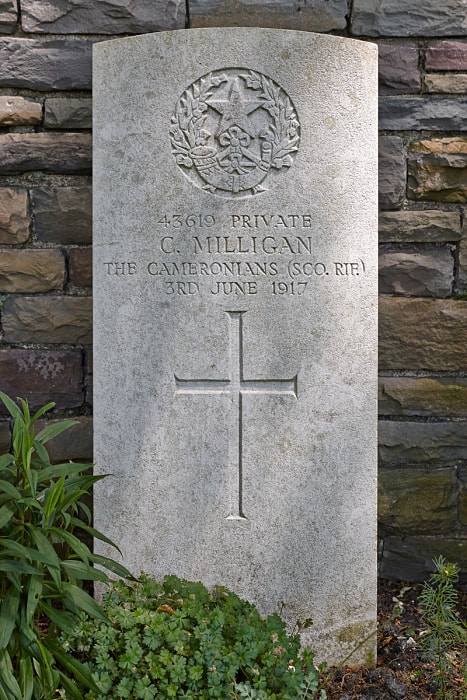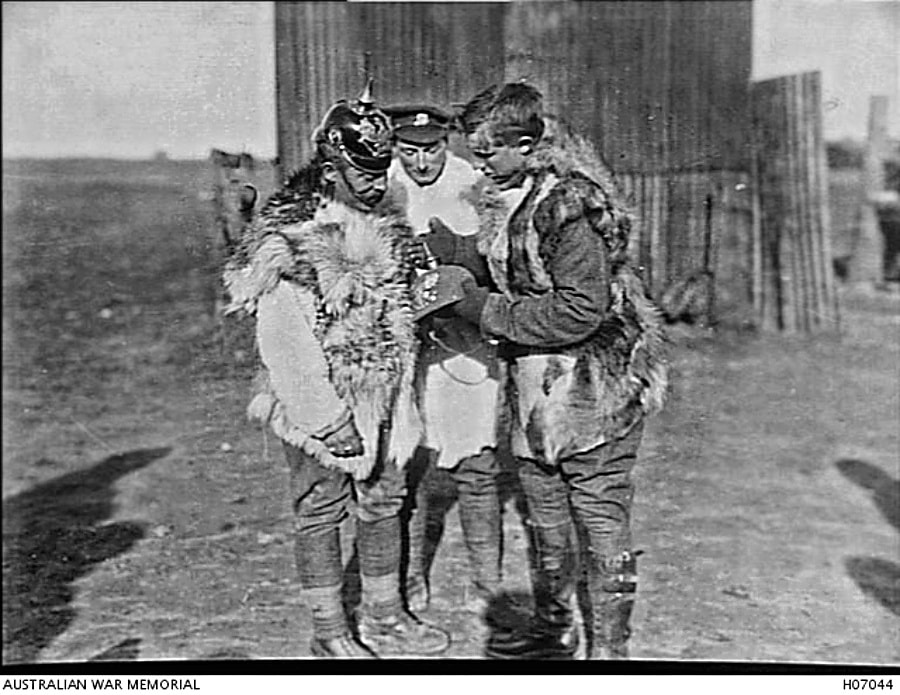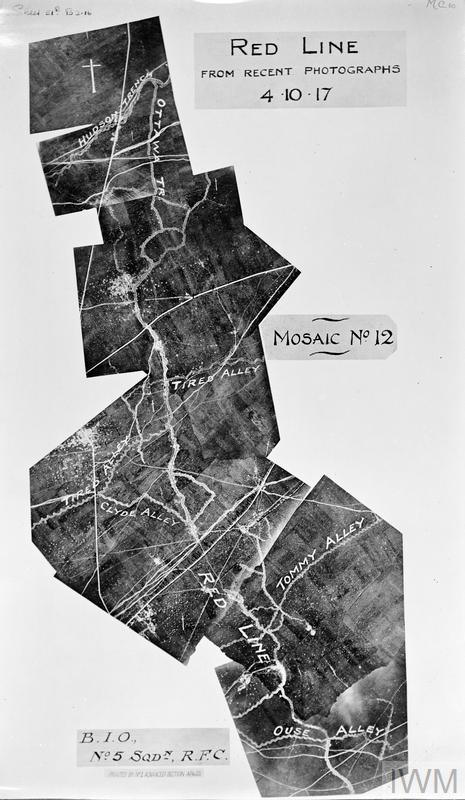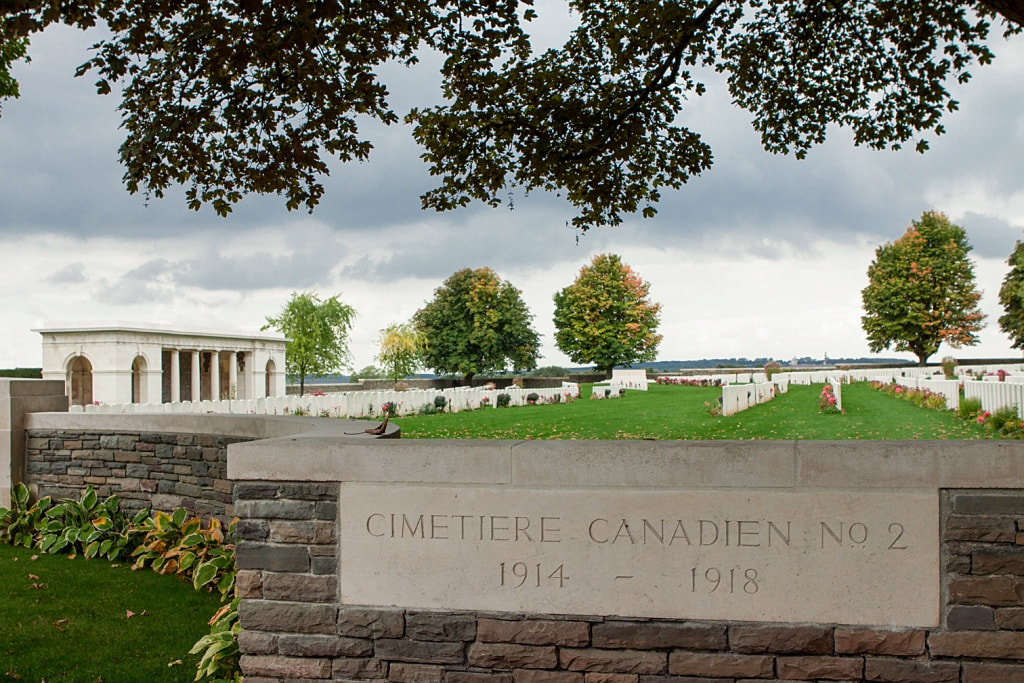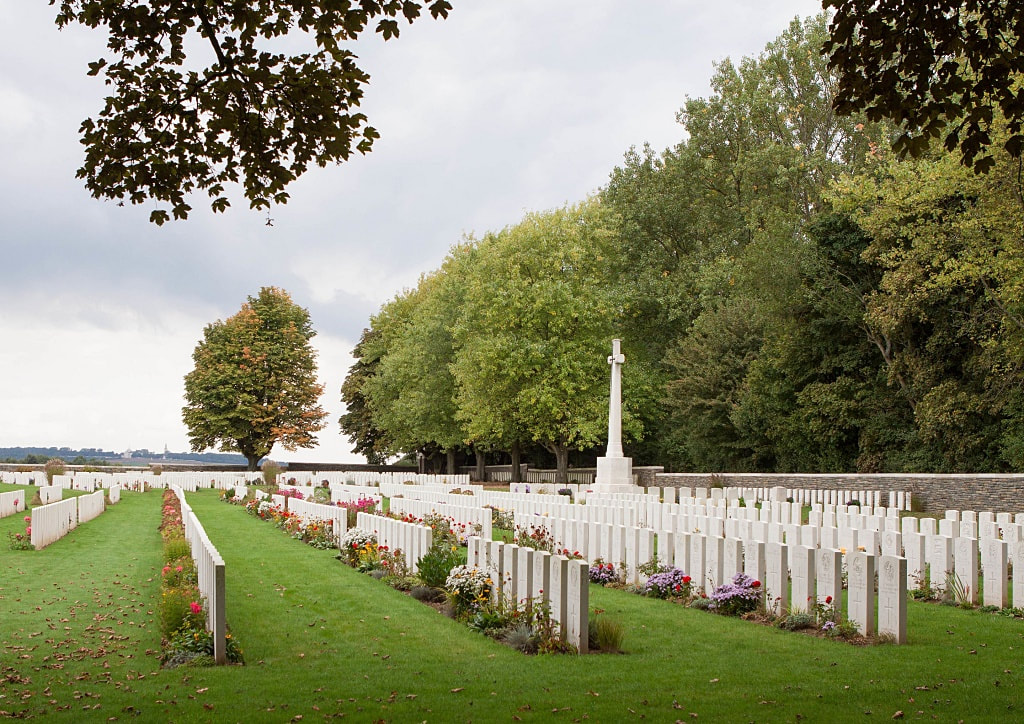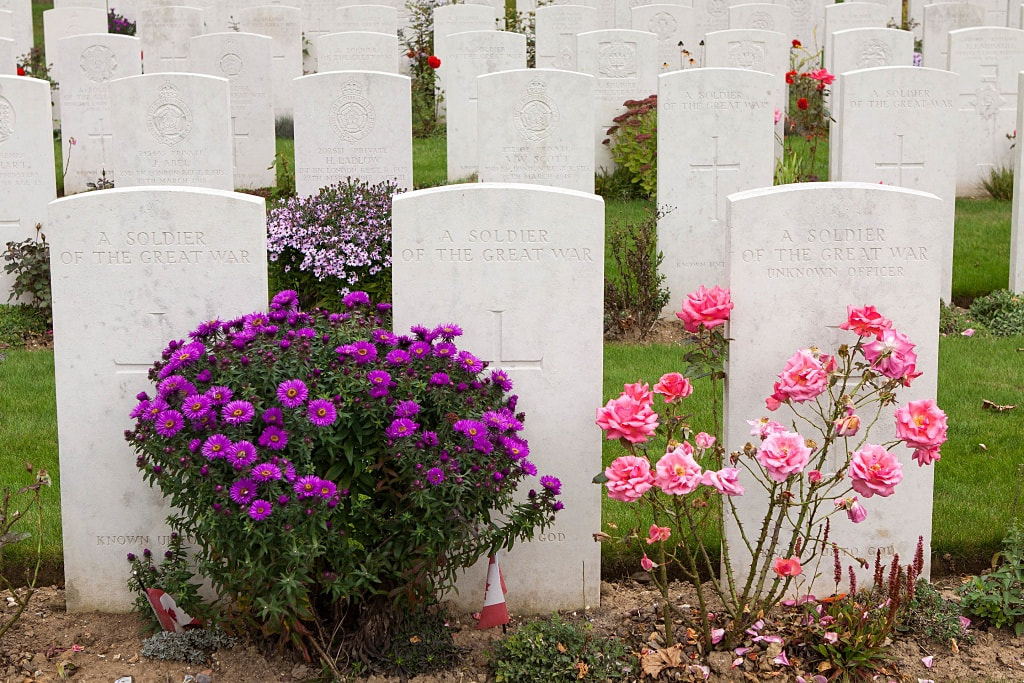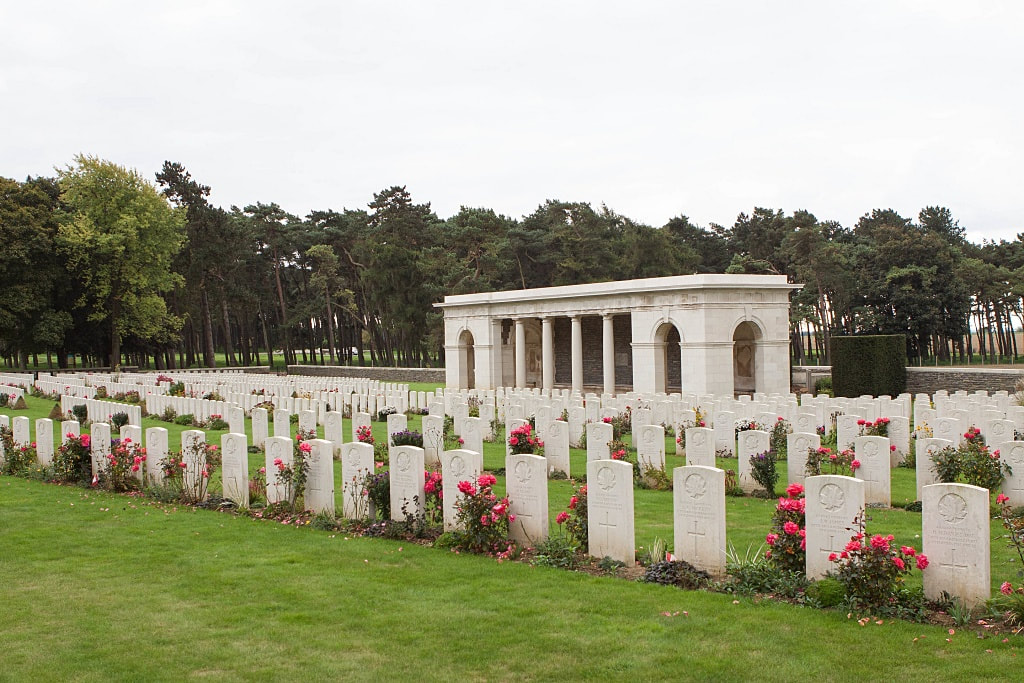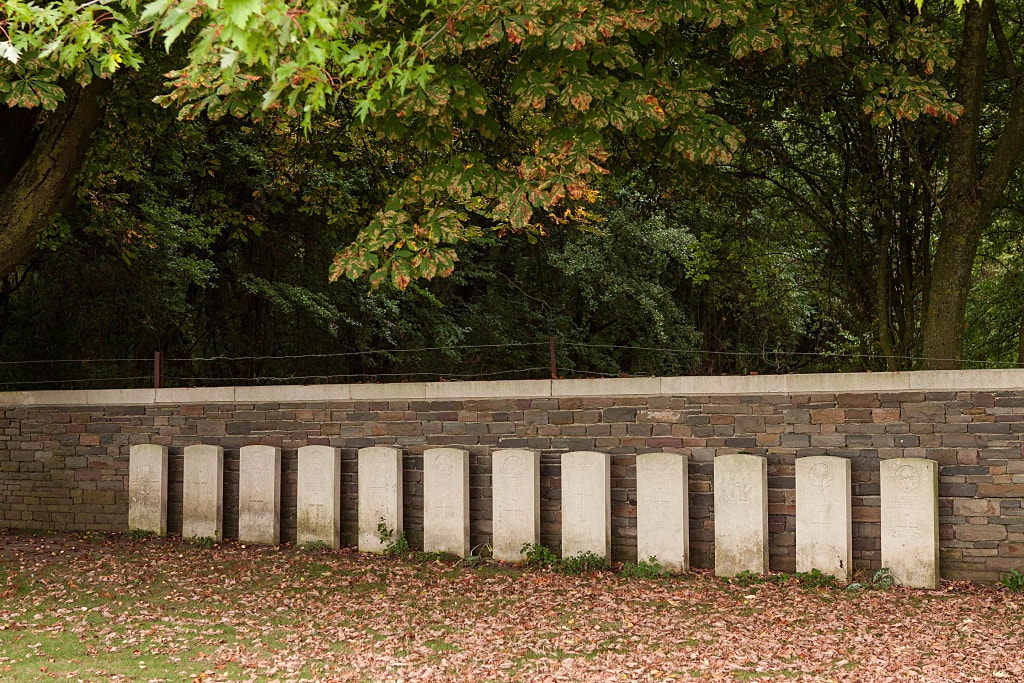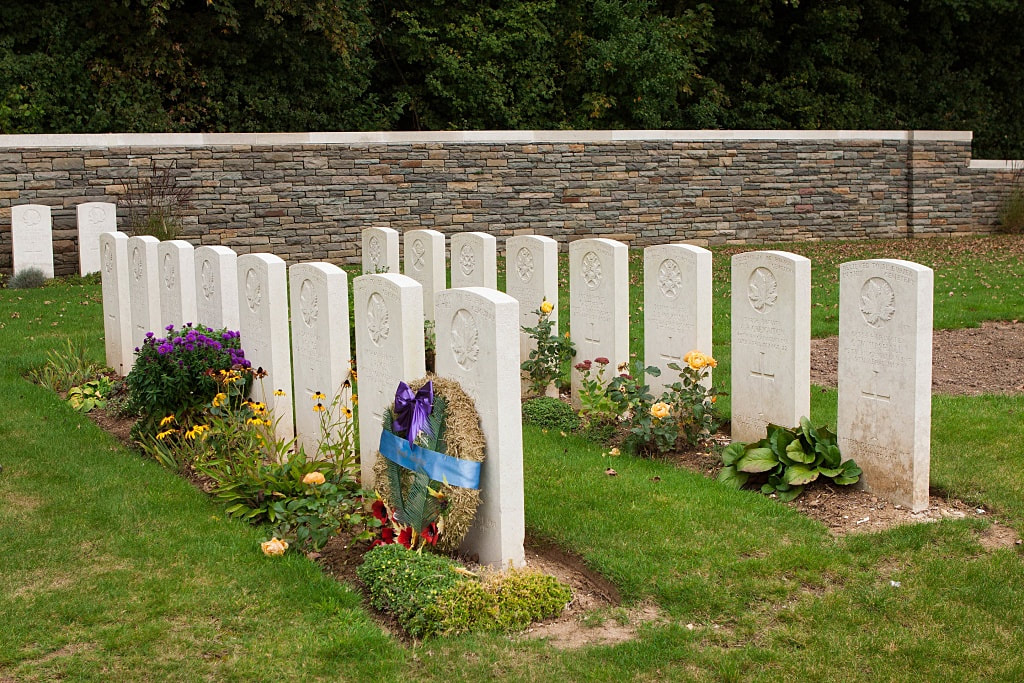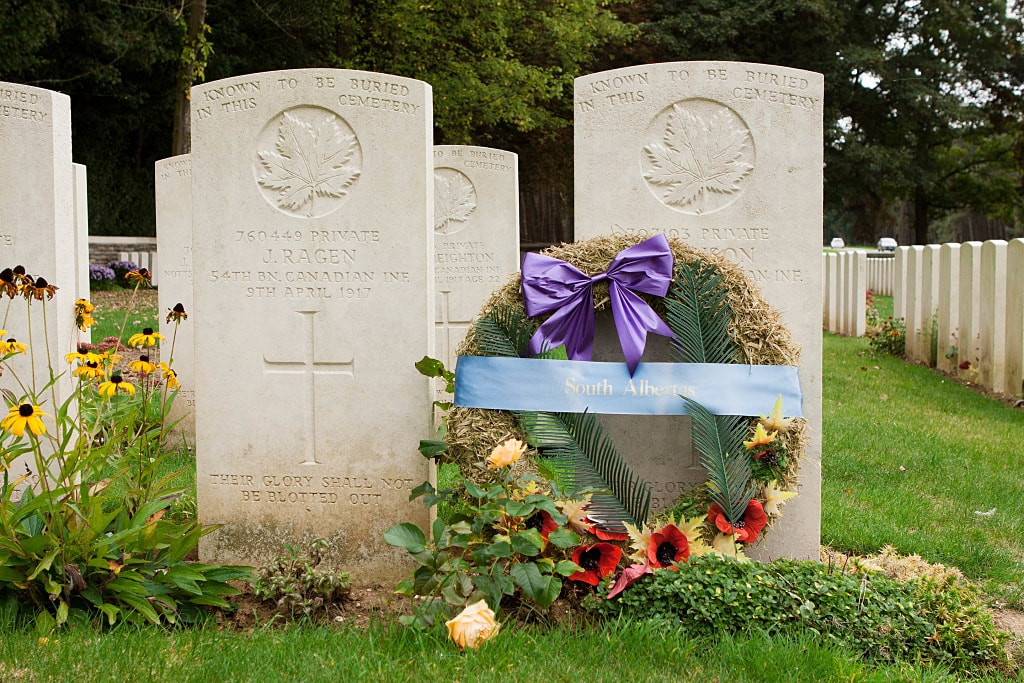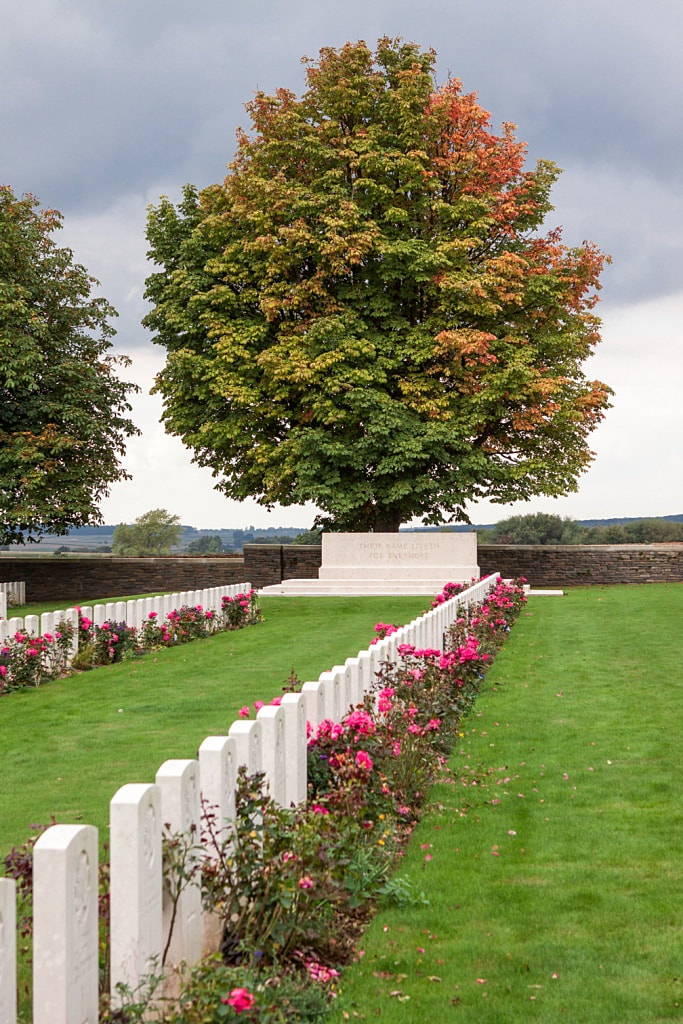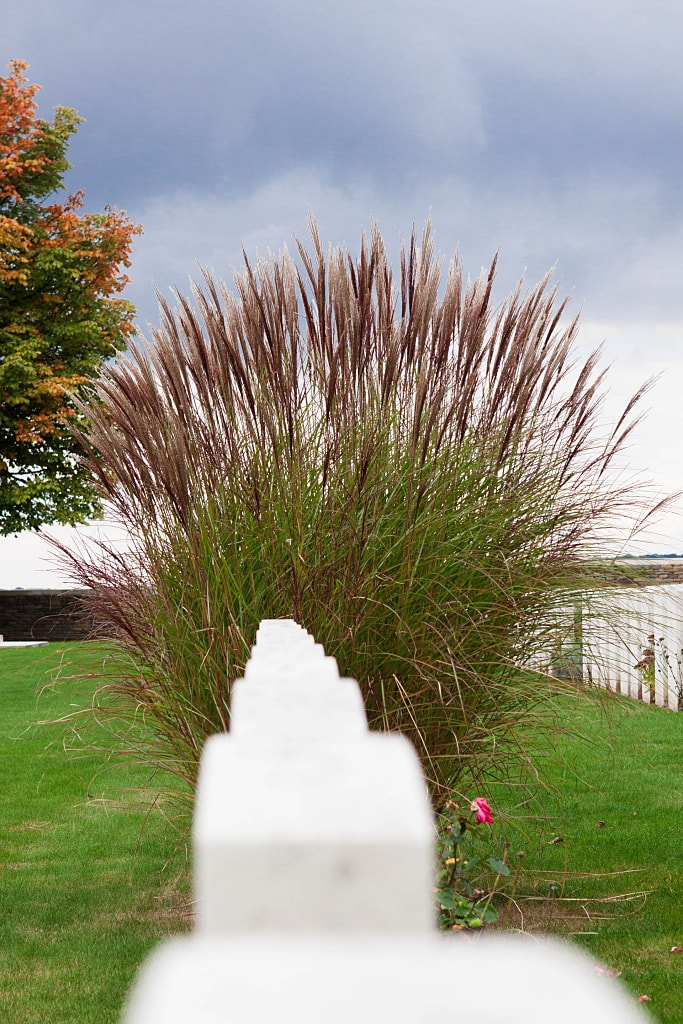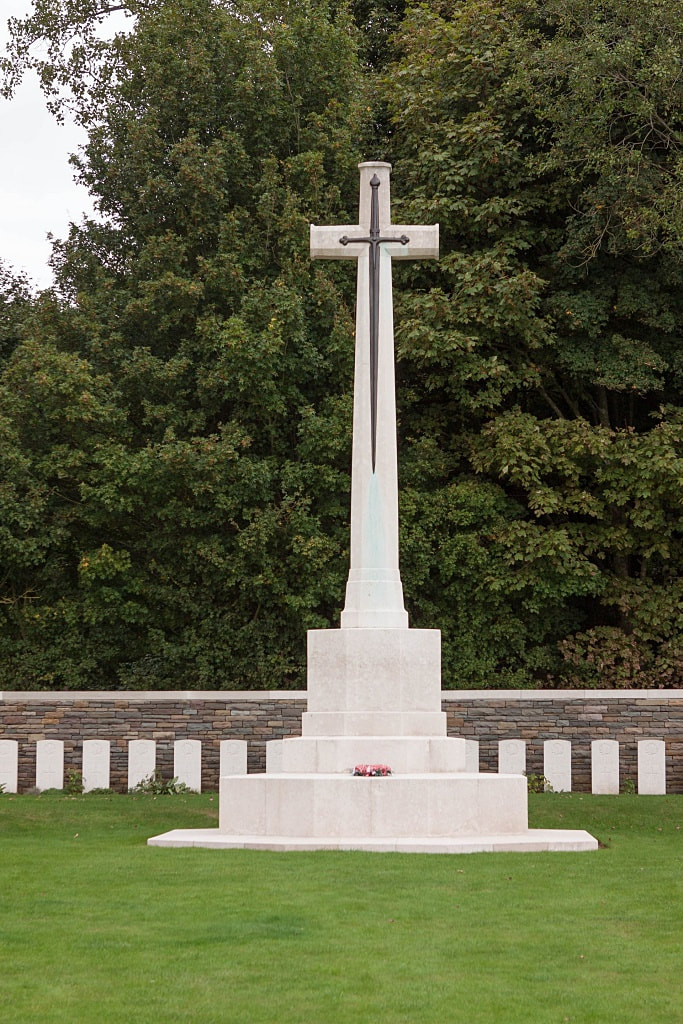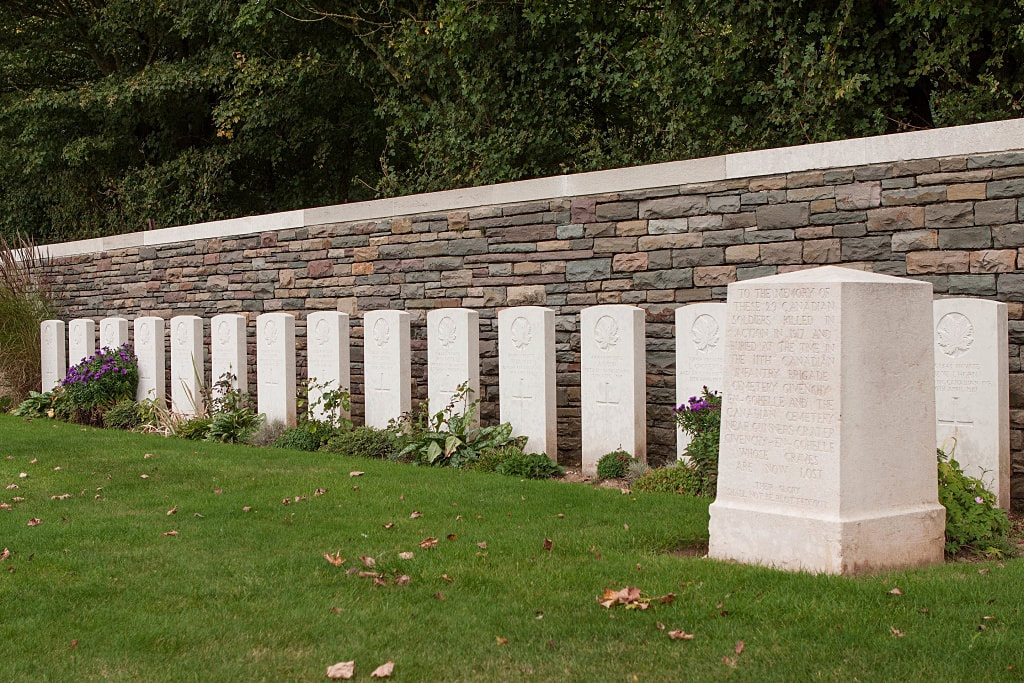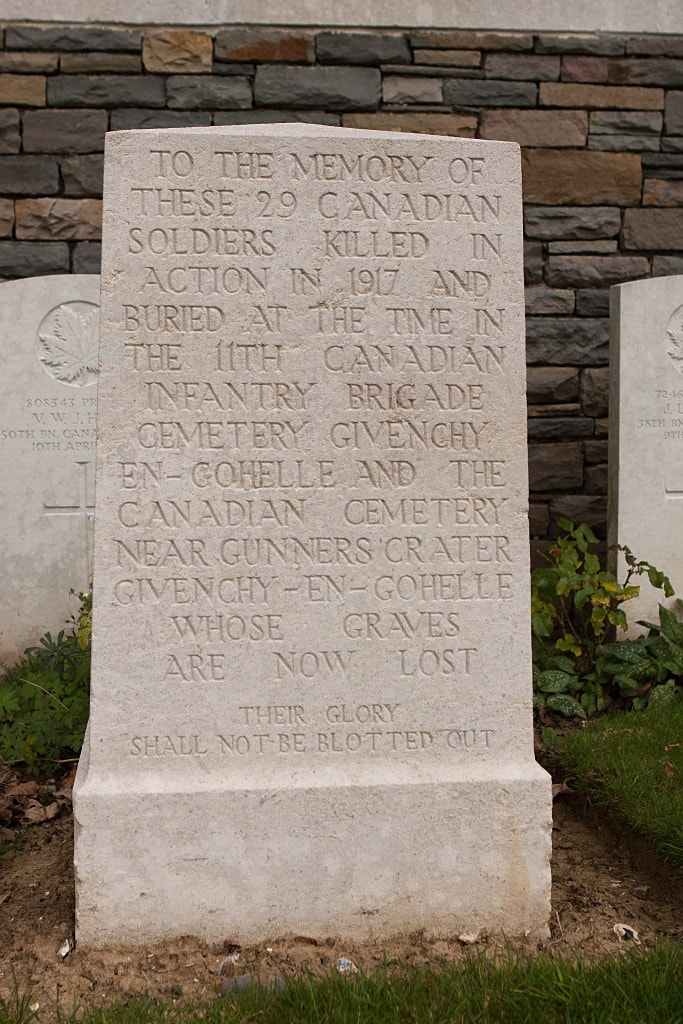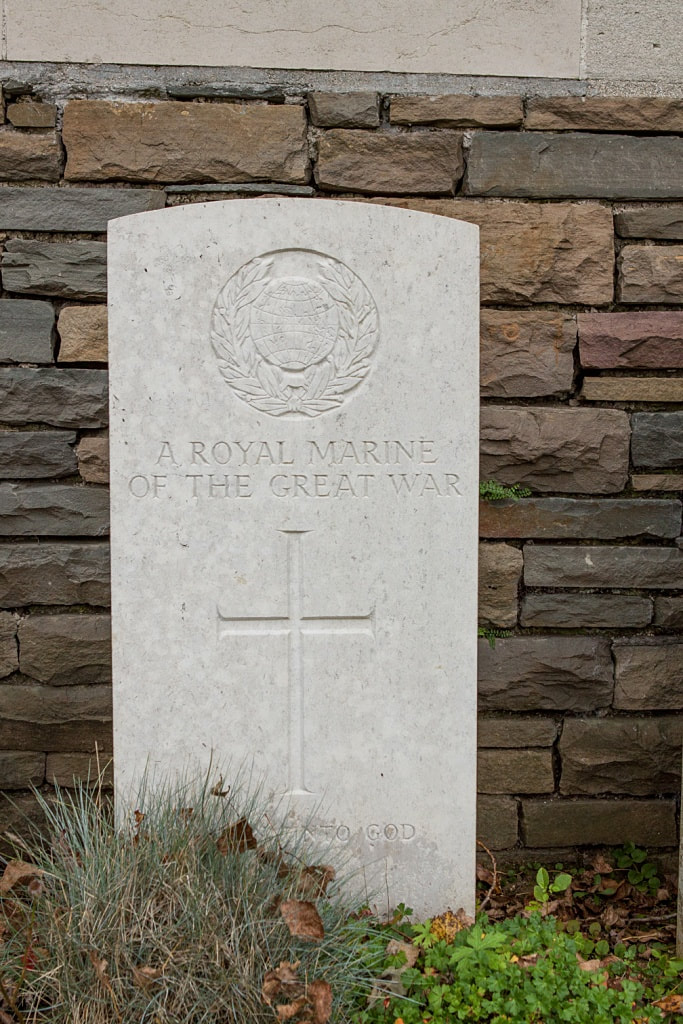CANADIAN CEMETERY NO. 2
Neuville-St. Vaast
Pas De Calais
France
GPS Coordinates: Latitude: 50.37725, Longitude: 2.76418
Image above © Carl Liversage @carl_liversage
Location Information
Neuville-St. Vaast is a village about 6 kilometres north of Arras and 1 kilometre east of the main road from Arras to Bethune.
The Cemetery is within the Canadian National Vimy Memorial Park, which is north of Neuville-St. Vaast. The main entrance to the Park is signposted from the Arras to Lens road (N17).
Historical Information
The cemetery was established by the Canadian Corps after the successful storming of Vimy Ridge on 9th April, 1917 and some of those buried in the cemetery fell in that battle or died of wounds received there, though the majority of the graves were made later for the burial of the dead recovered from surrounding battlefields and from isolated graves which were transferred into the cemetery over a period of years after the Armistice.
The cemetery covers an area of 10,869 square metres and is enclosed by low walls of coursed stone.
There are 2,966, 1914-18 war casualties commemorated in this site. 29 Canadian soldiers buried at the time in the 11th Canadian Infantry Brigade Cemetery, Givenchy-en Gohelle and the Canadian cemetery near Gunner's Crater, Givenchy-en-Gohelle but whose graves are now lost are commemorated by special memorial headstones, inscribed to this effect with the additional quotation, "Their Glory shall not be blotted out".
The cemetery was designed by Sir Reginald Blomfield and Noel Ackroyd Rew
Total Burials: 2,966.
Identified Casualties: Canada 467, United Kingdom 342, Australia 6, New Zealand 4, India 1. Total 820.
Dedications
760100 Private Thomas Benjamin Raper, 54th Bn. Canadian Infantry (Central Ontario Regiment) 9th April 1917, aged 20.
Remembered by great-great nephew, Eric Kraima
Neuville-St. Vaast is a village about 6 kilometres north of Arras and 1 kilometre east of the main road from Arras to Bethune.
The Cemetery is within the Canadian National Vimy Memorial Park, which is north of Neuville-St. Vaast. The main entrance to the Park is signposted from the Arras to Lens road (N17).
Historical Information
The cemetery was established by the Canadian Corps after the successful storming of Vimy Ridge on 9th April, 1917 and some of those buried in the cemetery fell in that battle or died of wounds received there, though the majority of the graves were made later for the burial of the dead recovered from surrounding battlefields and from isolated graves which were transferred into the cemetery over a period of years after the Armistice.
The cemetery covers an area of 10,869 square metres and is enclosed by low walls of coursed stone.
There are 2,966, 1914-18 war casualties commemorated in this site. 29 Canadian soldiers buried at the time in the 11th Canadian Infantry Brigade Cemetery, Givenchy-en Gohelle and the Canadian cemetery near Gunner's Crater, Givenchy-en-Gohelle but whose graves are now lost are commemorated by special memorial headstones, inscribed to this effect with the additional quotation, "Their Glory shall not be blotted out".
The cemetery was designed by Sir Reginald Blomfield and Noel Ackroyd Rew
Total Burials: 2,966.
Identified Casualties: Canada 467, United Kingdom 342, Australia 6, New Zealand 4, India 1. Total 820.
Dedications
760100 Private Thomas Benjamin Raper, 54th Bn. Canadian Infantry (Central Ontario Regiment) 9th April 1917, aged 20.
Remembered by great-great nephew, Eric Kraima
Images below © Carl Liversage @carl_liversage
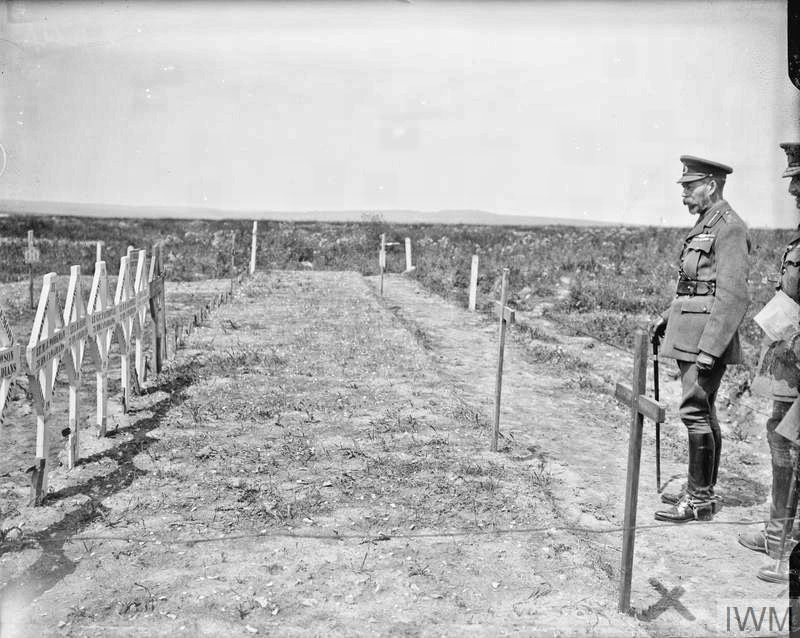
11th July 1917: King George V visiting the graves of Canadian soldiers on Vimy Ridge, 11 July 1917. Identified graves include servicemen of the 75th Battalion, Canadian Expeditionary Force: Lieutenant Lionel Hyman Eliot, Lieutenant Martin Jay Workman, and Lieutenant G.C. Faithful(l), all of whom were killed in action on 9 November 1917 and are now buried in Canadian Cemetery No.2.
Images in gallery below © Geerhard Joos
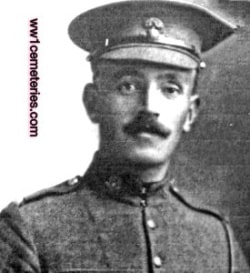
147929 Company Sergeant Major
David Wilson Aitken
78th Bn. Canadian Infantry
9th April 1917
Plot 5. D. 5.
David Wilson Aitken
78th Bn. Canadian Infantry
9th April 1917
Plot 5. D. 5.

SP/3084 Private
Joseph Edmund Alexander Anderson
24th Bn. Royal Fusiliers
13th November 1916, aged 24.
Plot 10. E. 9.
Son of John Bannatyne Anderson and of Minnie Jane Anderson (nee Boyd), of Lerwick, Zetland.
Joseph Edmund Alexander Anderson
24th Bn. Royal Fusiliers
13th November 1916, aged 24.
Plot 10. E. 9.
Son of John Bannatyne Anderson and of Minnie Jane Anderson (nee Boyd), of Lerwick, Zetland.
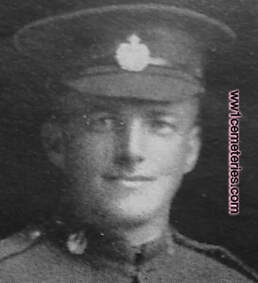
730450 Private
John Barbour
75th Bn. Canadian Infantry
9th April 1917, aged 29.
Plot 1. B. 5.
Son of James Barbour, and of Flora Jane Barbour, of 29, Spruce St., Galt, Ontario, Canada.
John Barbour
75th Bn. Canadian Infantry
9th April 1917, aged 29.
Plot 1. B. 5.
Son of James Barbour, and of Flora Jane Barbour, of 29, Spruce St., Galt, Ontario, Canada.
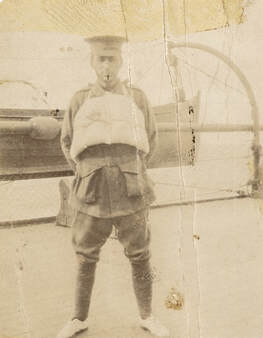
5424 Private
Albert Edward Beattie
20th Bn. Australian Infantry, A. I. F.
25th March 1917, aged 27.
Plot 12. B. 8.
Click on image to enlarge
Son of Mr. and Mrs. William Beattie, Gilmore, Tumut, New South Wales, Australia.
Informal portrait of 5424 Acting Corporal (A/Cpl) Albert Edward Beattie taken aboard A18 troopship to England. A teacher from Tumut, NSW, Beattie embarked with the 20th Battalion, 14 Reinforcements on 22 August 1916 aboard HMAT Wiltshire (A18). An A/Cpl whilst on the journey overseas, Beattie reverted to his enlistment rank of Private (Pte) upon arrival at Plymouth, England. In early 1917 Pte Beattie was detailed for clerical work at the Town Hall in Bapaume, France, where the 20th Battalion was billeted. On 25 March 1917 the Town Hall was destroyed by a delayed German mine, killing Pte Beattie and the other occupants. Pte Beattie was 27 years old.
Albert Edward Beattie
20th Bn. Australian Infantry, A. I. F.
25th March 1917, aged 27.
Plot 12. B. 8.
Click on image to enlarge
Son of Mr. and Mrs. William Beattie, Gilmore, Tumut, New South Wales, Australia.
Informal portrait of 5424 Acting Corporal (A/Cpl) Albert Edward Beattie taken aboard A18 troopship to England. A teacher from Tumut, NSW, Beattie embarked with the 20th Battalion, 14 Reinforcements on 22 August 1916 aboard HMAT Wiltshire (A18). An A/Cpl whilst on the journey overseas, Beattie reverted to his enlistment rank of Private (Pte) upon arrival at Plymouth, England. In early 1917 Pte Beattie was detailed for clerical work at the Town Hall in Bapaume, France, where the 20th Battalion was billeted. On 25 March 1917 the Town Hall was destroyed by a delayed German mine, killing Pte Beattie and the other occupants. Pte Beattie was 27 years old.
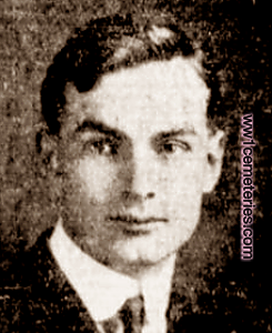
911863 Private
Fred Edward Campbell
46th Bn. Canadian Infantry
12th April 1917, aged 24.
Plot 4. A. 10.
Son of Albert Edward and Mary Jane Campbell, of 4120, Eton St., Vancouver, British Columbia, Canada.
Fred Edward Campbell
46th Bn. Canadian Infantry
12th April 1917, aged 24.
Plot 4. A. 10.
Son of Albert Edward and Mary Jane Campbell, of 4120, Eton St., Vancouver, British Columbia, Canada.
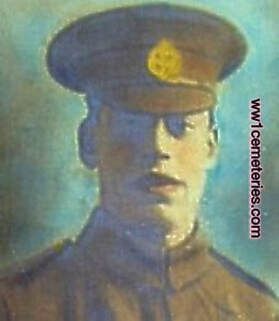
S/20494 Rifleman
James Charles Lawrence Clancy
3rd Bn. Rifle Brigade
14th April 1917, aged 20.
Plot 7. A. 1.
Son of Daniel Peter and Lucy Clancy, of 11, Lower Pellipar Rd., Woolwich, London.
His father was the leading side drummer in the 20th London Regt. Band. His brother, called Daniel also served in the 20th London Regt & 15th Royal Irish Rifles, severely gassed, but survived the war.
Picture courtesy of Bernard Harris, James Clancy's nephew.
James Charles Lawrence Clancy
3rd Bn. Rifle Brigade
14th April 1917, aged 20.
Plot 7. A. 1.
Son of Daniel Peter and Lucy Clancy, of 11, Lower Pellipar Rd., Woolwich, London.
His father was the leading side drummer in the 20th London Regt. Band. His brother, called Daniel also served in the 20th London Regt & 15th Royal Irish Rifles, severely gassed, but survived the war.
Picture courtesy of Bernard Harris, James Clancy's nephew.
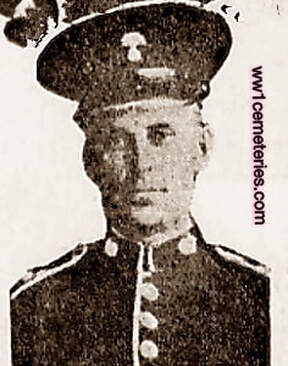
147125 Private
William McVicar Grant
78th Bn. Canadian Infantry
9th April 1917
Plot 5. B. 7.
William McVicar Grant
78th Bn. Canadian Infantry
9th April 1917
Plot 5. B. 7.

Lieutenant
Ernest Reece Kappele
75th Bn. Canadian Infantry
9th April 1917, aged 24.
Plot 1. A. 6.
Son of George Kappele, K.C., and of K. R. Kappele, of 235, Lonsmount Drive, Forest Hill, Toronto, Ontario, Canada.
Ernest Reece Kappele
75th Bn. Canadian Infantry
9th April 1917, aged 24.
Plot 1. A. 6.
Son of George Kappele, K.C., and of K. R. Kappele, of 235, Lonsmount Drive, Forest Hill, Toronto, Ontario, Canada.
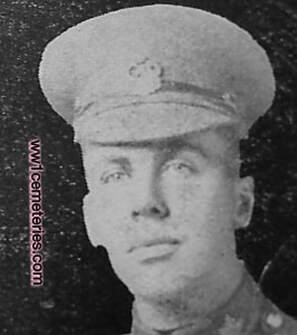
782182 Private
Louis Peter Steckenreiter
50th Bn. Canadian Infantry
10th April 1917, aged 29.
Sp. Mem. No. 26.
Son of Nicholas Steckenreiter, of Waterloo, Ontario.
Louis Peter Steckenreiter
50th Bn. Canadian Infantry
10th April 1917, aged 29.
Sp. Mem. No. 26.
Son of Nicholas Steckenreiter, of Waterloo, Ontario.
Shot at Dawn
43619 Private Charles M. Milligan, 10th Bn. Cameronians (Scottish Rifles), executed for desertion 3rd June 1917, aged 20. Plot 19. A. 14. He arrived in France in February 1916, & in October received a suspended sentence of 12 months’ imprisonment with hard labour for disobedience, followed by 42 days’ Field Punishment No 1 for another such offence in early 1917. Milligan went absent during the Battle of Arras just as his unit was preparing to attack — & was arrested 5 days later. At trial — where he chose to be unrepresented — he said that he had been unable to control his actions, while his Commanding Officer stated that his conduct ‘had not been good on the whole’, but that there was ’nothing to his discredit in the field’. However the brigade commander added that men even younger had been known to do their duty in the past. (Putkowski, p 174)
43619 Private Charles M. Milligan, 10th Bn. Cameronians (Scottish Rifles), executed for desertion 3rd June 1917, aged 20. Plot 19. A. 14. He arrived in France in February 1916, & in October received a suspended sentence of 12 months’ imprisonment with hard labour for disobedience, followed by 42 days’ Field Punishment No 1 for another such offence in early 1917. Milligan went absent during the Battle of Arras just as his unit was preparing to attack — & was arrested 5 days later. At trial — where he chose to be unrepresented — he said that he had been unable to control his actions, while his Commanding Officer stated that his conduct ‘had not been good on the whole’, but that there was ’nothing to his discredit in the field’. However the brigade commander added that men even younger had been known to do their duty in the past. (Putkowski, p 174)

